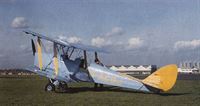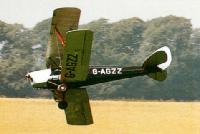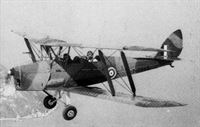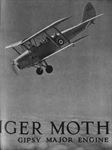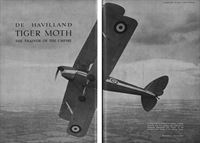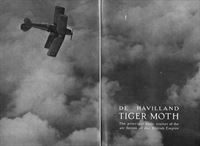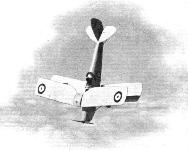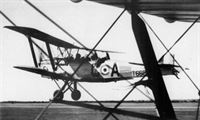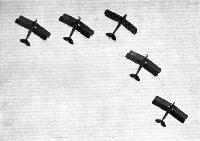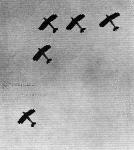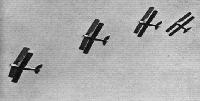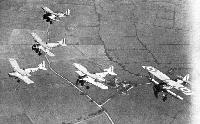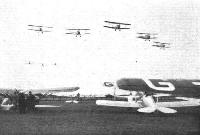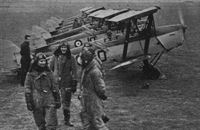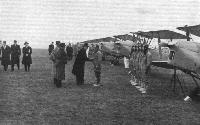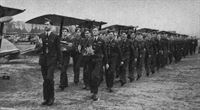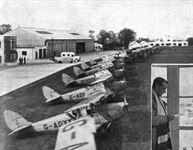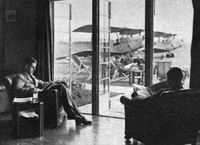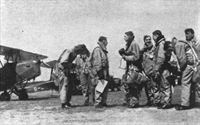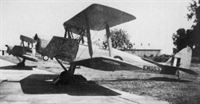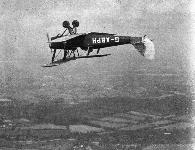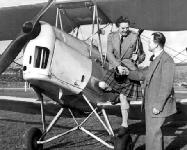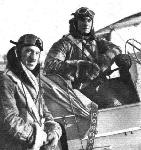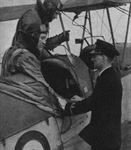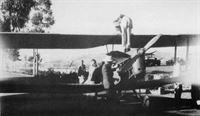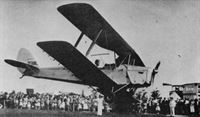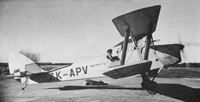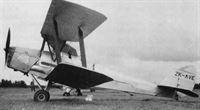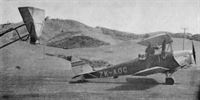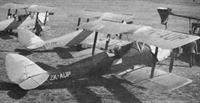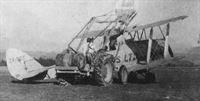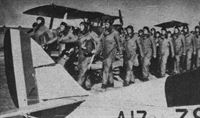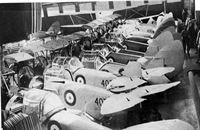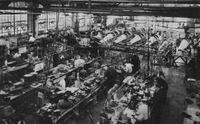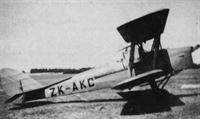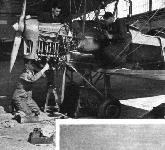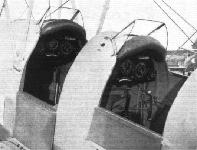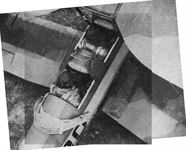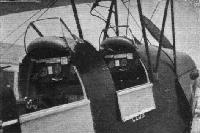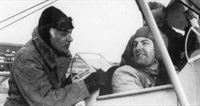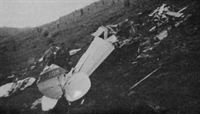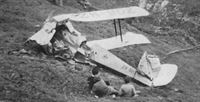
Описание
Страна : Великобритания
Год : 1931
Двухместный учебный и спортивный самолет
Варианты
- De Havilland - Tiger Moth / D.H.82 - 1931 - Великобритания
- De Havilland - Queen Bee / D.H.82B - 1935 - Великобритания
- Thruxton - Jackaroo - 1957 - Великобритания
de Havilland DH.82 Tiger Moth
Успех DH.60 Moth стимулировал разработку военной версии машины, известной как DH.60T Moth Trainer. По сравнению с гражданскими вариантами, конструкцию DH.60T усилили для полетов с большей массой. Он мог оснащаться подвеской для четырех практических бомб массой по 9,1-кг под фюзеляжем, а также фотопулеметом либо АФА различных типов для разведки. Поэтому Moth Trainer годился для обучения пилотов, бомбардиров и стрелков. Для облегчения аварийного выхода из передней кабины расчалки были наклонены вперед к передней части крепления корневой части крыла, а дверцы кабины - увеличены. Стойки центроплана все еще окружали переднюю кабину, однако в новом учебно-боевом самолете, разработанном по спецификации 15/31, их сдвинули вперед для облегчения покидания машины. Смещение центра тяжести, вызванное этим смещением крыльев, компенсировали, придав консолям небольшую стреловидность. Был установлен перевернутый рядный мотор Gipsy III мощностью 120 л. с. (90 кВт) и скошенный капот, обеспечивший лучший обзор из кабины пилота.
Построили восемь предсерийных экземпляров с тем же обозначением DH.60T, но с новым наименованием Tiger Moth. За ними последовала машина с увеличенным поперечным "V" и стреловидностью нижнего крыла. Этот самолет получил новое обозначение DH.82. Он впервые поднялся в воздух 26 октября 1931 года. По спецификации 23/31 заказали 35 таких машин под военным обозначением Tiger Moth Mk I. В ноябре 1931 года первые из них прибыли в учебную часть FTS №3. Другие поступили в часть CFS в мае 1932 года. Звено из пяти летчиков CFS показало свое мастерство и перевернутый пилотаж на новом учебно-боевом самолете на аэрошоу 1932 года в Хендоне. Подобные машины поставлялись на экспорт в Бразилию, Данию, Персию, Португалию и Швецию. Еще два самолета со спаренными поплавками фирмы "Short Brothers" были построены по спецификации T.6/33 для оценки британскими ВВС.
Затем де Хэвилленд разработал улучшенную версию с мотором Gipsy Major I мощностью 130 л. с. (97 кВт) и фанерной (вместо полотняной) обшивкой фюзеляжа. Этот самолет назвали DH.82A или Tiger Moth Mk II. ВВС Британии заказали 50 таких машин по спецификации T.26/33. На Tiger Moth Mk II имелся съемный колпак, которым можно было накрыть заднюю кабину для обучения полетам по приборам. Первые машины поступили в Кинли с ноября 1934 по январь 1935 года. Другие попали в летные школы авиакомпаний "Bristol Aeroplane Company", "de Havilland School of Flying", "Brooklands Aviation Ltd", "Phillips and Powis School of Flying", "Reid and Sigrist Ltd", "Airwork Ltd" и "Scottish Aviation Ltd".
Эти компании участвовали в обучении резервистов для британских ВВС. В августе 1939 года действовало не менее 44 таких школ, хотя 20 из них закрылись с началом войны.
До Второй мировой войны бипланы Tiger Moth строили по лицензии в Норвегии, Португалии, Швеции и Канаде. Фирма "de Havilland Aircraft of Canada" собрала 227 DH.82A. Позднее эта компания построила 1520 бипланов DH.82C зимней версии с мотором Gipsy Major IC мощностью 145 л. с. (108 кВт) с переделанным капотом, сдвижным фонарем, обогревом кабины, колесными тормозами и хвостовым колесом вместо стандартного костыля. При необходимости вместо колес могли устанавливаться лыжи либо поплавки. Некоторые экземпляры, для которых не хватало двигателей Gipsy Major, оснащались моторами Menasco Pirate D.4 мощностью 160 л.с. (119 кВт). 200 DH.82C, от которых отказались канадские ВВС, заказали ВВС США под обозначением PT-24.
После начала войны гражданские машины мобилизовали в ВВС Британии для связи и обучения, а также заказали для военных нужд новую большую партию. 795 самолетов собрали на заводе в Хэтфилде, затем этот завод перевели на серийное производство самолетов Mosquito. Линию по сборке Tiger Moth восстановили на заводе фирмы "Morris Motors Ltd", где изготовили до 3500 машин, фирма "de Havilland Aircraft of New Zealand" построила еще 345 бипланов, а австралийская фирма "de Havilland Aircraft Pty" отправила военным заказчикам 1085 машин.
17 сентября 1939 года, всего через две недели после объявления войны, звено "А" эскадрильи связи британского экспедиционного корпуса (позднее 81-я эскадрилья) отправили во Францию. Всю зиму и весну 1940 года бипланы Tiger Moth этой части летали в северной Франции, поддерживая связь вплоть до эвакуации британских войск из Дюнкерка. Уцелевшие самолеты перелетели в Великобританию.
Бипланы Tiger Moth также готовили к ударам по возможному немецкому десанту. Под задней кабиной либо под нижним крылом устанавливали пилоны для подвески восьми бомб калибра 9,1 кг. Хотя было изготовлено и распределено по летным школам до 1500 комплектов пилонов, ни один такой самолет не применили в боях. Ранее, в декабре 1939 года, сформировали шесть эскадрилий прибрежного дозора, пять из них оснастили бипланами Tiger Moth. Они не могли атаковать субмарины, но звук их моторов и возможность обнаружения могли заставить немецких подводников погрузиться, тем самым помешав возможным атакам на корабли. На Дальнем Востоке несколько Tiger Moth переделали в санитарные самолеты, увеличив багажный отсек и расширив его створки, чтобы туда можно было поместить носилки с раненым.
Однако наибольший вклад в победу Tiger Moth внес в качестве учебного самолета. Машинами этого типа оснастили 28 школ начальной летной подготовки в Британии, 25 в Канаде (плюс четыре школы радистов), 12 в Австралии, четыре в Родезии (плюс школа инструкторов летного дела), семь в Южной Африке и две в Индии.
Также необходимо упомянуть радиоуправляемый самолет-мишень DH.82B Queen Bee, представлявший собой упрощенную цельнодеревянную версию Tiger Moth. Он имел фюзеляж от Moth Major, крылья от Tiger Moth, мотор Gipsy Major, электрогенератор с приводом от крыльчатки и бензобак большой емкости. 5 января 1935 года прототип облетали с ручным управлением, затем собрали 380 машин для обучения пилотов-истребителей, зенитчиков и воздушных стрелков.
До конца войны собрали более 8000 аэропланов Tiger Moth. С окончанием войны многие из них попали на гражданский рынок. ВВС Британии передали много бипланов для гражданского и военного применения в Бельгию, Францию и Нидерланды. Кроме обучения, спорта и досуга они стали применяться в самых неожиданных ипостасях. Многие оказались ценными помощниками в сельском хозяйстве, что оказалось очень важным для Новой Зеландии. Ряд самолетов оборудовали закрытыми кабинами для повышения комфорта пилота и пассажира. Самую серьезную переделку осуществила британская компания "Jackaroo Aircraft Ltd", расширив фюзеляж для посадки четырех пассажиров попарно, плечом к плечу. В период с 1957 по 1959 год собрали 19 таких машин под названием Thruxton Jackaroo, включая варианты с открытой кабиной пилота и закрытым салоном. В 2010 году во всем мире еще летало изрядное число этих "долгожителей".
ТАКТИКО-ТЕХНИЧЕСКИЕ ХАРАКТЕРИСТИКИ
de Havilland DH.82C Tiger Moth
Тип: двухместный учебный и спортивный самолет
Силовая установка: рядный поршневой мотор de Havilland Gipsy Major 1С мощностью 145 л.с. (108 кВт)
Летные характеристики: максимальная скорость 172 км/ч на оптимальной высоте; крейсерская скорость 145 км/ч на оптимальной высоте; начальная скороподъемность 229 м/мин; практический потолок 4450 м; дальность полета 443 км
Масса: пустого самолета 506 кг; максимальная взлетная 828 кг
Размеры: размах крыльев 8,94 м; длина 7,29 м; высота 2,69 м; площадь крыльев 22,20 м2
Описание:
- de Havilland DH.82 Tiger Moth
- Flight, November 1931
The New “Tiger Moth” - Flight, November 1932
British Aircraft - Flight, October 1933
THE "TIGER MOTH" FIGHTER - Flight, March 1938
British light aircraft - Flight, September 1939
To-day's Light Aeroplanes
Фотографии
-
Мировая Авиация 48
Регистрационный номер: T7449 DH.82A Tiger Moth Mk II. В 1950 году этот самолет базировался на базе британских ВВС Фэйроукс. Он несет стандартную окраску учебного послевоенного самолета. Надпись "RUL" - это условное обозначение эскадрильи лондонского университета в Командовании резерва. В 1939 году Tiger Moth сменили самолеты Avro Tutor, эксплуатация продолжалась до начала 1950-х годов, когда появились de Havilland Canada Chipmunks. T7449 был одним из самолетов, построенных компанией "Morris Motors Ltd", Коули, Оксфорд.
-
Мировая Авиация 245
Регистрационный номер: R5130 [5], G-APOV [5] Этот DH.82A Tiger Moth Mark II в годы Второй мировой войны эксплуатировался в 3-м перегоночном звене, в транспортной авиации и 3-м училище летчиков-инструкторов. Самолет летал до 1953 года, но после войны использовался гражданскими организациями под регистрацией G-APOV.
-
Мировая Авиация 245
До войны гражданские Tiger Moth строились по лицензии в Норвегии, Португалии и Швеции. ВВС Швеции использовали Tiger Moth до 1958 года под обозначением Sk 11A.
-
Мировая Авиация 104
Этот красочный DH.82A сохраняется в летном состоянии в Музее шведских ВВС в Мальме. Швеция построила три аэроплана DH.82 и 20 DH.82A по лицензии.
-
Aeroplane Monthly 1976-12 / D.H.82A Tiger Moth /Preservation Profile/ (44)
Регистрационный номер: HB-UBC [6]
-
Air Pictorial 1999-11 / Register Review
Регистрационный номер: XL716, G-AOIL The Tiger Moth G-AOIL is now flying again after a lengthy rebuild. It was one of four ex-civil machines acquired by the Royal Navy in 1956 for glider towing and for use by the Royal Naval Engineering College
-
Авиация и Космонавтика 2021-10 / Некоторые знаменательные даты октября в истории авиации
Регистрационный номер: K2585 [5], G-ANKT [4], T6818 [4] -
Мировая Авиация 139
Регистрационный номер: K4259 Эксплуатация классического DH.82A Tiger Moth в гражданских авиашколах началась в 1930-х годах, а во время войны машина стала основным самолетом первоначального обучения в британских ВВС. Сотни таких самолетов остаются в пригодном к полетам состоянии даже сегодня, многие несут "историческую" военную окраску.
-
Мировая Авиация 245
Регистрационный номер: N5444 Tiger Moth является развитием более раннего DH.60M, от которого отличался крылом с большим углом стреловидности с вырезом, облегчавшим летчикам покидание кабин с парашютом. Угол стреловидности крыла пришлось увеличить для сохранения устойчивости самолета на прежнем уровне после внедрения вырезов. На снимке: самолет в британской военной окраске, машина принадлежит частному владельцу из США.
-
Aeroplane Monthly 1997-06 / M.Oakey - Vintage news
Регистрационный номер: K2587 [2] Russell’s “technical replica” D.H.82 Tiger Moth “K2567”.
-
Aeroplane Monthly 1973-07
Регистрационный номер: N9714 -
Jane's All the World Aircraft 1980 / Encyclopedia of Aviation - Aircraft A-Z - v3
de Havilland D.H.82A Tiger Moth.
-
Авиация и Время 2013-04 / С.Дроздов - Air Squadron в Украине
Регистрационный номер: G-ANRF [3], XL714 Три самолета DH-82 "Тайгер Мот" во время демполетов. Жуляны, 4 июля 2013г.
-
Air International 2007-05 / AIR International Aviation Photographer Of The Year Competition /Photography competition/
Old Warden airfield forms a timeless backdrop for this pastoral view of a Tiger Moth taking off. Eric Grey has captured the theme of 'a passion for aviation' in the look of glee on the face of the passenger in the front cockpit.
-
Aeroplane Monthly 1994-05 / M.Oakey - Grapevine
Регистрационный номер: T7793 D.H. Tiger Moth T7793 being suspended under the glass dome of Croydon’s old airport terminal on February 26, 1994. It has been put on display by Westmead Business Group, which acquired the historic terminal in 1992 and has restored it as offices.
-
Aeroplane Monthly 1983-12 / De Havilland D.H.82A Tiger Moth G-ACDC /Preservation Profile/
Регистрационный номер: G-ACDC [7], BB726 [7] -
Aeroplane Monthly 1993-10
Регистрационный номер: G-ACDC [7], BB726 [7] Calling all Santas! On December 19, 1993 Compton Abbas, down in Dorset, is holding a Santa Flies In Fly-in. This one was snapped during a delivery in veteran Tiger Moth G-ACDC some years ago.
-
Мировая Авиация 210
Регистрационный номер: G-ACDJ [8] Этот G-ACDJ, поддерживаемый и ныне в летном состоянии, является вариантом DH.82A довоенной постройки и одним из старейших летающих Tiger Moth. Этот снимок сделан еще в 1955 году, когда машина летала в окраске летной школы "de Havilland".
-
Aeroplane Monthly 2000-12 / M.Hooks - Archive Photographs. Croydon Colour /Early colour photography/
Регистрационный номер: G-ACDJ [8] Surrey & Kent Flying Club adopted this blue-and-yellow colour scheme in the mid-1950s and it appeared on Tiger Moths, Chipmunks and a Prentice. Tiger G-ACDJ is still airworthy and attended the Moth Club Rally at Woburn in August 2000.
-
Aeroplane Monthly 1977-11
Регистрационный номер: G-ADGV [5], BB694 [5] Air Cdre A. H. Wheeler poses his beautifully-restored Tiger Moth, G-ADGV, for AIR PORTRAITS near Old Warden Airfield on August 27, 1977. This venerable aeroplane has been a regular visitor to this season's Shuttleworth Collection displays.
-
Aeroplane Monthly 1994-04 / M.Oakey - Grapevine
Регистрационный номер: G-ADPC Royal Navy Historic Flight CO Lt-Cdr John Beattie is about to retire - but he is staying airborne in, among other aircraft, his own Tiger Moth G-ADPC.
-
Мировая Авиация 210
Регистрационный номер: G-AGPK Наряду с другими пилотажными бипланами, наподобие американского Stearman Kaydet, Tiger Moth используется в качестве платформы для подобных акробатических упражнений на крыле. Каркас для акробата крепится или к кабану верхнего крыла, или к боковым поверхностям фюзеляжного топливного бака.
-
Мировая Авиация 6
Регистрационный номер: G-AGZZ Многие британские летчики приобретали свой опыт пилотажа на самолетах D.Н.82А Tiger Moth разработки "de Havilland". Самолет любим за легкость в управлении и вызывает чувство ностальгии, но не идеален в плане взаимодействия инструктора и ученика из-за раздельных кабин.
-
Мировая Авиация 141
Регистрационный номер: G-ANEL [2], N9238 [2] Двухместный De Havilland DH.82 Tiger Moth остается весьма популярным среди желающих совершить развлекательный полет или же получить первоначальные навыки пилотирования.
-
Aviation Historian 10 / M.Hiscock - Alias Thunderbird 6
Регистрационный номер: G-ANFM [6], T5888 [6] Tiger Moth G-ANFM in its garish film livery but without the polystyrene passengers added for the bridge sequence. The red sections of the paint scheme are remnants of the Tiger Moth’s previous solid red scheme with a bare-metal engine cowling. For the film the top wing’s upper surface had a “sunburst”-type pattern applied.
-
Aviation Historian 10 / M.Hiscock - Alias Thunderbird 6
Регистрационный номер: G-ANFM [6], T5888 [6] “Thunderbird 6” in the rather more tasteful colour scheme it wears today with the Reading Flying Group, which operates from White Waltham. The Tiger Moth is something of a film veteran, having also appeared in The Little Prince in 1974, The Awakening of Emily (1976), Agatha (1979) and, most recently, The King’s Speech in 2010.
-
Aeroplane Monthly 1982-01
Регистрационный номер: DF155 [3], G-ANFV [3] Tiger Moth G-ANFV/DF155, formerly owned by the Strathallan Aircraft Collection, flying in May 1979. This aircraft was sold in the auction and is now based at Lossiemouth.
-
Мировая Авиация 84
Регистрационный номер: G-ANKT [4], K2585 [5], T6818 [4] Семейство самолетов Tiger Moth представлено в коллекции в варианте DН.82А (G-ANKT). Для сезона 2009 года он был оформлен в виде самолета 1930-х годов с кодом K2585 пилотажного звена Центральной летной школы британских ВВС.
-
Aeroplane Monthly 1976-12 / B.Williams - On tour with Cobham's Circus
Регистрационный номер: G-ANOH [3] S. J. Carr’s de Havilland Tiger Moth in 1930-period scheme at Old Warden in June 1976.
-
Aeroplane Monthly 1993-06 / R.Anthoine - No shots, please - we're British (12)
Регистрационный номер: G-APFU [4], EM879 [4] -
Aeroplane Monthly 1997-03 / M.Oakey - Vintage news
Регистрационный номер: G-ASKP [2] Two D.H. Tiger Moths have recently reappeared on the scene. UK-based G-ASKP, repaired by Acebell Aviation at Redhill following a landing mishap last September, is now in maroon and silver to match its Tiger Club stablemate G-ACDC.
-
Aeroplane Monthly 1997-03 / M.Oakey - Vintage news
Регистрационный номер: G-AZGZ, NM181 Frank Manning's Tiger Moth G-AZGZ/NM181.
-
Air Pictorial 1999-10
Регистрационный номер: G-AZZZ [2] Acquired by DH Moth Club secretary and event organiser, Stuart McKay MBE, in 1970, and painstakingly restored to return to the air on December 4, 1998, Tiger Moth G-AZZZ carries the elegant colour scheme of Capt Geoffrey de Havilland’s personal DH.60G Moth, G-AAAA.
-
Aeroplane Monthly 1999-10
Регистрационный номер: G-AZZZ [2] Stuart McKay’s Tiger Moth is painted in the same style as Capt Geoffrey de Havilland’s personal D.H.60G Moth G-AAAA.
-
Aeroplane Monthly 1991-03
Регистрационный номер: G-BFHH [3] GORDON BAIN'S stunning shot of de Havilland D.H.82A Tiger Moth G-BFHH (and matching lighthouse) was taken on October 17, 1989, off Beachy Head, East Sussex. The pilot was Peter Harrison.
-
Мировая Авиация 210
Регистрационный номер: G-BMPY Большинство Tiger Moth, летающих по всему свету и в наше время, отличаются яркой окраской. Подавляющая часть из них является бывшими военными машинами, попавшими на рынок после войны.
-
Air Pictorial 1999-10
Регистрационный номер: D-EEAJ, D-EHHT The two German-registered Tigers, D-EEAJ and HHT.
-
Aeroplane Monthly 2000-02 / J.Stroud - A million miles flown /A lifetime of flying/
Регистрационный номер: AP-AKM Early morning at the Karachi Flying Club, with a colourful group by one of the club’s de Havilland Tiger Moths on January 17, 1960.
-
Aeroplane Monthly 1976-12 / D.H.82A Tiger Moth /Preservation Profile/ (44)
Регистрационный номер: HB-UBC [6] Werner Ulmer’s beautiful Tiger Moth
-
Aeroplane Monthly 1985-11
Регистрационный номер: DF128 [2], G-AOJJ [2] STUART HOWE photographed D.H. Tiger Moth DF128/G-AOJJ, piloted by Ted Lay, over Woburn during the de Havilland Moth Club's event on August 17 this year.
-
Aeroplane Monthly 1993-12
Регистрационный номер: T7230 [2] Phil Shaw and Malcolm Paul's de Havilland D.H.82A Tiger Moth T7230, photographed by RICHARD WINSLADE.
-
Aeroplane Monthly 1993-05 / S.Harding - RNZAF Historic Flight
The flight’s immaculate D.H.82A Tiger Moth was originally accepted by the RNZAF on October 4, 1940. It had a long and varied career in both military and civilian guises, and now wears the markings it carried while assigned to 2 EFTS in 1941-42.
-
Aeroplane Monthly 1999-11 / P.Franzini - A Late Renaissance /Italy's warbird scene/ (2)
Регистрационный номер: PG641, PG651, T6256 The Rusty Angels aerobatic team perform a tied-together routine at Padua’s warbird airshow on June 1995.
-
Aeroplane Monthly 1993-05 / S.Harding - RNZAF Historic Flight
The Historic Flight’s Harvard and Tiger Moth join two Central Flying School CT4 Airtrainers and a Bell Sioux helicopter in a flypast over Wigram. The Historic Flight is under CFS supervision, and its aircraft share a hangar with the New Zealand-built Airtrainers, the design of which is based on the Australian Victa Airtourer.
Другие самолёты на фотографии: Bell H-13 Sioux / Model 47 - США - 1945North American T-6 Texan / AT-6 Harvard - США - 1935PAC CT/4 Airtrainer - Новая Зеландия - 1972
-
Мировая Авиация 115
Регистрационный номер: NZ1459 В фонде имелись три машины фирмы "de Havilland". DH.82 Tiger Moth (фото) был построен в Новой Зеландии и служил в ВВС этой страны 1940-е и 1950-е годы. Этот самолет все еще летает в коллекции.
-
Авиация и Время 2013-02 / А.Хаустов - Aero India-2013
Регистрационный номер: HU-512 Отреставрированный DH-82 Tiger Moth
-
Aeroplane Monthly 1997-03 / M.Oakey - Vintage news
Регистрационный номер: F-AZPP, T8857 Two D.H. Tiger Moths have recently reappeared on the scene. At Epinal-Dogneville in France, Philippe Pitetand his father Pierre have completed their ten-year “basket case” rebuild of F-AZPP in pre-war RAF training colours.
-
Aeroplane Monthly 1999-10 / P.Franzini - A Late Renaissance /Italy's warbird scene/ (1)
Регистрационный номер: I-GATO The most famous Italian display duo: Zanardo’s Tiger Moth I-GATO with its “enemy”, replica Fokker Dr I I-LYNC.
Другие самолёты на фотографии: Fokker Dr.I - Германия - 1917
-
Мировая Авиация 245
Регистрационный номер: C-GBBH, DE991 Довольно узкая колея шасси, управляемый костыль и отсутствие тормозов колес ограничивали использование Tiger Moth с травяных аэродромов в ветреную погоду. Машина с канадской регистрацией сфотографирована в 2009 году.
-
Aeroplane Monthly 1996-08 / M.Oakey - Vintage news
Hosted by the Portuguese Air Force’s (PAF) No 301 (Tiger) Squadron at Beja in Southern Portugal in the week beginning May 20, the 1996 Nato Tiger Meet for Tiger-badged units worldwide was a success despite an aerial collision between a Hawk and an F-16 during the air display. The event featured various participants including the Italian Air Force’s last 21 Sqn Starfighter MM.6716/53-21, shown, and the PAF Historic Flight de Havilland Tiger Moth 102, painted in special markings for the occasion.
-
Aeroplane Monthly 1998-09 / M.Oakey, T.Harmsworth - Vintage news
Регистрационный номер: VH-NOV [2], A17-757 [2] Barry Markham’s Tiger Moth VH-NOV at Cambridge on June 24, 1998, with civil registration painted over its RAAF markings A17-757 to comply with international regulations.
-
Aeroplane Monthly 1998-09 / M.Oakey, T.Harmsworth - Vintage news
Регистрационный номер: VH-NOV [2], A17-757 [2] Carole and Barry Markham enjoying champagne provided by Marshall’s.
-
Aeroplane Monthly 1999-11 / T.Hall - Cutaway Kings: Peter Endsleigh Castle /Cutaway drawings/
Peter at the naming ceremony for the Tiger Moth restored in memory of celebrated flying instructor Cecil Pashley by his 95-year-old widow, Vera, at Shoreham Airport on June 11, 1997. In November 1995 he had made a painting depicting the aircraft as it would appear in its post-restoration scheme, flying at 800ft over Northbrook College and the airport buildings.
-
Air Enthusiast 1994-09 / S.Bohill-Smith - On the Wings of a Klemm
The DH 82a Tiger Moth was restored first, followed by the Klemm. Both aircraft are finished in their original Swedish Air Force training colours.
Другие самолёты на фотографии: Klemm Kl.35 / Kl.106 - Германия - 1935
-
Aeroplane Monthly 1988-08 / D.Hanson, H.Potgieter - Tigers over the Okavango
Регистрационный номер: ZS-CKX [7], ZS-DHR [2] HERMAN POTGIETER'S superb cover photograph depicts three South African Tiger Moths over the Okavango Delta
-
Aeroplane Monthly 1990-05
Регистрационный номер: ZS-CKX [7] This month's stunning photograph, by HERMAN POTGIETER, features South African Tiger Moth ZS-CKX coming out of a loop over Botswana's Okavango Delta in 1988.
-
Aeroplane Monthly 1997-06 / M.Oakey - Vintage news
Регистрационный номер: T7842 A tri-national threesome of World War Two trainers took to the skies over Suffolk recently: Stearman PT-17 40-1766 (furthest from the camera), flown by owner and wartime Arnold Training Scheme veteran Ed Boulter with Air UK Fokker F.100 captain Bruce Monk; former Lightning pilot Mark Zipfell flying de Havilland Tiger Moth T7842; and Air UK Fokker F.28 pilot Pete Brand flying Bucker Jungmann G-RETA.
Другие самолёты на фотографии: Bucker Bu.131 Jungmann - Германия - 1934Stearman PT-13 / PT-17 Kaydet / Model 73 (Boeing-Stearman) - США - 1934
-
Aeroplane Monthly 1999-05 / 1999 UK Airshows & Museums Guide
The Stampe SV-4C and Tiger Moths of the Tiger Club’s aerobatic Biplane Trio.
Другие самолёты на фотографии: Stampe et Vertongen SV-4 - Бельгия - 1933
-
Aeroplane Monthly 2000-04 / 2000 Airshows & Museums Guide
AFTER 15 years on the airshow circuit, the sky-filling Diamond Nine Tiger Moth display team will be hanging up their collective flying helmets after the 2000 season. Set up in 1985 by Charles Shea-Simonds utilising nine privately-owned Tigers, the team is renowned for its routine of gentlemanly, synchronised aerobatics. The Diamond Nine team usually performs at about 12 airshows every summer, but for this final season some 15 venues will be visited. Fifteen years on, about a third of the original members are still with the team, which at the moment comprises a rotating roster of about 15 pilots.
-
Aeroplane Monthly 1986-08
A unique formation of Tiger Club aircraft, comprising five Tiger Moths, six Rollason Turbulents and five Stampes.
Другие самолёты на фотографии: Druine D.3 Turbulent - Франция - 1950Stampe et Vertongen SV-4 - Бельгия - 1933
-
Мировая Авиация 210
Регистрационный номер: CF-CKF [3] Этот DH.82C канадской постройки, сфотографированный на озере Онтарио в 1985 году, оснащен поплавковым шасси для эксплуатации с многочисленных канадских водоемов. Построенный компанией "de Havilland of Canada" на заводе в Торонто в 1942 году, CF-CKF начал свою службу в качестве учебного самолета канадских ВВС.
-
Aeroplane Monthly 1996-08 / M.Vines - La Ferte-Alais '96
One of the Sails Collection’s “Albatros C IIs", converted from a Tiger Moth.
Другие самолёты на фотографии: Albatros C.I - Германия - 1915
-
Aeroplane Monthly 1979-10 / A.Jackson - D.H.82 Tiger Moth /RAF Piston Trainers/ (6)
Регистрационный номер: G-ABNJ The D.H.60T Tiger Moth test aircraft, E5/G-ABNJ, at Martlesham in August 1931 with the low-set bottom mainplanes.
-
Aeroplane Monthly 1983-12 / Brrrr! de Havilland
Регистрационный номер: K2567 [4], G-MOTH [4] Taxying out for take-off. Note the absence of anti-spin strokes and the fabric and stringer fuselage decking characteristic of early production Tiger Moths.
-
Flight 1932-06 / Flight
Регистрационный номер: K2570 [6] DE HAVILLAND "TIGER MOTH": "Gipsy III" engine.
-
Flight 1931-11 / Flight
Регистрационный номер: K2570 [6] GOOD LINES: When one becomes accustomed to the downward slope forward resulting from the installation of the Gipsy III engine, the "Tiger Moth" is of pleasing appearance.
-
Flight 1934-05 / Flight
Регистрационный номер: K2570 [6] FOR NAVIGATIONAL TRAINING: A D.H. "Tiger Moth" fitted with a hood for instruction in the art of "blind flying." As previously recorded in FLIGHT, a number of "Tiger Moths" so equipped have been ordered for the Royal Air Force. The particular machine illustrated belongs to No. 24 (Communications) Squadron.
-
Flight 1931-11 / Flight
Регистрационный номер: K2570 [6] THREE-QUARTER REAR VIEW: Both planes are swept back, but only the lower has a dihedral.
-
Flight 1931-11 / Flight
Регистрационный номер: K2570 [6] THE NEW "TIGER MOTH": This three-quarter front view shows the small obstruction to view presented by the Gipsy III engine.
-
Aeroplane Monthly 1981-11 / News Spotlight
Регистрационный номер: K2572 [3], G-AOZH [3], NM129 [3] On September 13, 1981, a large gathering of Tiger Moths assembled to celebrate the type's 50th birthday. The immaculate example illustrated here was doped trainer yellow and silver and bore the RAF serial number K2572 representing an aircraft from the first production batch of 1931-32.
-
Aeroplane Monthly 1987-12
Регистрационный номер: K2572 [3], G-AOZH [3], NM129 [3] GORDON BAIN photographed Vic Wheeler's D.H.82A Tiger Moth G-AOZH/NM129/"K2572" on August 20 this year
-
Aeroplane Monthly 1982-02 / Skywriters
Регистрационный номер: K2572 [3], G-AOZH [3], NM129 [3] I have been rebuilding my Tiger Moth over the last five years, during my lunch breaks, but only as a static model for display purposes. My Tiger Moth is also painted with the serial number K2572 and I assume this is authentic having found the batch order number on the fuselage to be: NERO/MCO/R/SO 1744 DTD 308 & 83A C and having checked through paperwork and found it to be from the original 1931-32 batch. North Ferriby, B. H. CLARKE North Humberside.
-
Aeroplane Monthly 1987-09 / Personal album
Регистрационный номер: K2592 D.H. Tiger Moth K2592 was part of a batch of 35 RAF Tigers delivered between October 1931 and January 1932. In addition to spending time at Kai Tak, this Tiger was later stationed at Tengah. K2592 was converted to a seaplane in May 1934. On December 15, 1940 K2592 crashed at Kranji, Singapore.
-
Aeroplane Monthly 1980-06 / R.Gillman - Pilot's progress (2)
Регистрационный номер: N9181 Taking off under the hood. N9181 during instrument training at Yatesbury in April 1940.
-
Jane's All the World Aircraft 1946 / 03 - All the world's aeroplanes
Регистрационный номер: R4922 [2] The D.H. Tiger-Moth II Two-seat Primary Training Biplane (130 h.p. D.H. Gipsy-Major engine).
-
Мировая Авиация 48
Регистрационный номер: R4922 [2] Большинство экипажей британских ВВС и многие пилоты из стран Содружества во время Второй мировой войны обучались на Tiger. Самолет активно использовался в Великобритании и других странах даже в 1950-х годах.
-
Aeroplane Monthly 1984-05 / J.Allan - Down in the Glen
All 18 University Air Squadrons were equipped with de Havilland Tiger Moths after the Second World War. Machines belonging to Glasgow UAS bore the codes RUG, and those belonging to Aberdeen UAS bore RUA. Tigers continued in service with UASs and RAF Volunteer Reserve units until February 1955, when the last few were replaced by Chipmunks.
-
Aeroplane Monthly 1980-06 / R.Gillman - Pilot's progress (2)
Регистрационный номер: N7966 Seen flying over Lake Mead, near the borders of Arizona and Nevada, is Ray Upton's D.H.82A Tiger Moth N7966. Ray is flying the aircraft from the rear cockpit, with Gary W. McConnell along for the ride.
-
Air International 1982-08 / J.Fricker - Tiger tails
Регистрационный номер: R5130 [5], G-APOV [5] A Tiger Moth in RAF standard training configuration in 1940, showing the absence of anti-spin strokes, and the gas detection diamond on the fuselage forward of the fin. Note the Handley Page slats on the upper wing, seen here in the closed position, and the large ailerons on the lower mainplanes, which were not particularly effective at large angles of deflection and low airspeeds.
-
Aeroplane Monthly 1989-01 / Photographic Competition Winners
Регистрационный номер: T5672, G-ALRI First prize goes to Jon Mynard of Milton Keynes for his photograph above of Brian Woodford's de Havilland D.H.82A Tiger Moth G-ALRI/T5672, taken at the Moth Club Rally at Woburn on August 20, 1988. Jon wins a Ferguson Videostar CCR FCO5 video camera, worth £1,100.
-
Aeroplane Monthly 1983-03 / D.H.82A Tiger Moth T6645/G-AIIZ /Preservation Profile/
Регистрационный номер: T6645 [5], G-AIIZ [5] As T6645 flying over Hong Kong harbour in July 1977.
-
Aeroplane Monthly 1983-03 / D.H.82A Tiger Moth T6645/G-AIIZ /Preservation Profile/
Регистрационный номер: T6645 [5], G-AIIZ [5] -
Aeroplane Monthly 1980-06 / R.Gillman - Pilot's progress (2)
Typical of almost every EFTS is this scene at No 10 EFTS, RAF Yatesbury in August 1940.
-
Aeroplane Monthly 1980-01 / R.Wilson, R.Winslade - Naval Nostagia
Регистрационный номер: T8191 Tiger Moth T8191 cannot fly in formation with the Sea Fury because its maximum speed in level flight is below the fighter's stalling speed.
-
Jane's All the World Aircraft 1980 / Encyclopedia of Aviation - Aircraft A-Z - v3
de Havilland D.H.82A Tiger Moth.
-
Aeroplane Monthly 1982-11 / P.Jarrett - Grapevine
Регистрационный номер: T6818 [4], G-ANKT [4], K2585 [5] Shuttleworth's new de Havilland hangar was officially opened on August 29, 1982 by Grp Capt John Cunningham. George Ellis flew the Collection's Tiger Moth T6818 overhead in salute.
-
Aeroplane Monthly 1984-12 / ??? - Ancient and Modern
Регистрационный номер: DE709 Tiger Moth DE709 of the Light Aircraft School at Middle Wallop takes a look at Stonehenge in July 1952.
-
Flight 1938-03 / Flight Advertisements
Регистрационный номер: L6923 [8] -
Aeroplane Monthly 1986-11 / M.Oakey - Grapevine
Регистрационный номер: T7404 Tigerfly's pleasure-flying de Havilland Tiger Moth, resplendent in RAF wartime training yellow and camouflage.
-
Aeroplane Monthly 1991-08 / de Havilland D.H.82A Tiger Moth G-ANKZ/N6466 /Preservation Profile/
Регистрационный номер: G-ANKZ [2], N6466 [2] G-ANKZ/N6466 as she appears today. PAUL TOMLIN took the photograph on July 14, 1990, with Rowan Stephens flying 'KZ from Barton.
-
Flight 1937-11 / Flight
Регистрационный номер: L6923 [8] The R.A.F. is but one of many military air services employing the versatile De Havilland Tiger Moth trainer. The engine is the Gipsy Major.
DE HAVILLAND TIGER MOTH: Trainer (Gipsy Major engine - 130 h.p. at sea level); span, 29ft. 4in.; gross weight, 1,825 lb.; max. speed, 109 m.p.h. -
Flight 1937-10 / Flight
Регистрационный номер: L6923 [8] -
Flight 1940-01 / Flight Advertisements
Регистрационный номер: L6923 [8] -
Air International 1982-08 / J.Fricker - Tiger tails
Регистрационный номер: R5130 [5], G-APOV [5] -
Aeroplane Monthly 1981-03 / R.Nesbit - Navigator's progress (1)
Регистрационный номер: R5130 [5], G-APOV [5] Classic shot by The Aeroplane of R5130, later converted to a Jackaroo and registered G-APOV in 1960.
-
Flight 1940-10 / Flight Advertisements
Регистрационный номер: R5130 [5], G-APOV [5] In large-scale production in England, Canada, Australia and New Zealand and employed in thousands throughout the Empire as the principal basic trainer of the fighting forces.
-
Flight 1937-10 / Flight
Регистрационный номер: L6923 [8] The photograph of the Tiger Moth, which looks rather upset in the hands of Test-Pilot Buckingham, was obtained on quite a different occasion. Below the clouds it was just an ordinary grey overcast autumn day, yet here again are blue sky and sunshine unlimited.
-
Flight 1938-02 / Flight Advertisements
Регистрационный номер: L6923 [8] -
Aeroplane Monthly 1979-10 / A.Jackson - D.H.82 Tiger Moth /RAF Piston Trainers/ (6)
Регистрационный номер: L6923 [8] Aerobatic training in L6923, 1939.
-
Flight 1937-10 / Flight
Регистрационный номер: L6923 [8] -
Flight 1939-03 / Flight
The De Havilland Tiger Moth is a well-established type on which thousands of pilots have been trained and which is still in large-scale quantity production.
-
Aeroplane Monthly 1993-10 / Personal album. Military
Регистрационный номер: T6742 4FTS Tiger Moth T6742 flying over the “Bundu” from Heany in 1948. One of a batch of 2,000 Tigers delivered between May 1940 and April 1941, T6742 was diverted to the South African Air Force in October 1941 to become 2218. In May 1947 it returned to the RAF.
-
Aeroplane Monthly 1981-09 / Personal album
Регистрационный номер: DX709 [2] Tiger Moth DX709 was built by de Havilland Aircraft Pty, in Australia during the war. Large numbers of Australian-built Tigers were shipped to Southern Rhodesia and South Africa for use under the Commonwealth Air Training Plan. The engine cowlings of the example here look somewhat battered.
-
Aeroplane Monthly 1993-10 / Personal album. Military
Регистрационный номер: DX709 [2] 4 FTS Tiger Moth DX709 flying from Heany in 1948 with Terry Kingswood and his instructor obviously enjoying the experience.
-
Air International 1982-08 / J.Fricker - Tiger tails
A Tiger Moth II photographed by the author in 1949 at which time it was serving with No 17 RFS, Hornchurch. Note the folded blind-flying hood behind the rear cockpit.
-
Aeroplane Monthly 1979-10 / A.Jackson - D.H.82 Tiger Moth /RAF Piston Trainers/ (6)
Регистрационный номер: K4288 Tiger Moth K4288 of No 18 EFTS, Fairoaks, in all-silver training colours, 1946.
-
Aeroplane Monthly 1979-10 / A.Jackson - D.H.82 Tiger Moth /RAF Piston Trainers/ (6)
Регистрационный номер: G-ANKT [4], T6818 [4], K2585 [5] Tiger T6818/G-ANKT, owned by the Shuttleworth Trust. Note the authentic gas-detection panel.
-
Aeroplane Monthly 1993-10 / Personal album. Military
Регистрационный номер: MC542 Tiger Moth MC542 of 4 FTS, Rhodesian Air Training Group, climbing out of Heany aerodrome - visible in the haze in the background - in May 1949.
-
Aeroplane Monthly 1993-10 / Personal album. Military
Регистрационный номер: DX600 A close-up of David Vernon flying Tiger Moth DX600 from Heany in 1948.
-
Авиация и Космонавтика 2018-09 / В.Морозов - В желтой, жаркой Африке: Авиация Родезии и Зимбабве (1)
Регистрационный номер: MC562 DH.82 «Тайгер Мот» из «Родезийской Учебной Авиагруппы». Фото периода 1941-1946 гг.
-
Aeroplane Monthly 1981-09 / Personal album
Регистрационный номер: T6629 [2] No 4 FTS Tiger Moth, T6629, seen during local formation flying in the vicinity of RAF Heany. Five Elementary and Reserve Flying Training Schools in the Rhodesian Air Training Group were equipped with Tiger Moths between the years of 1937-39 and it was the last biplane trainer in the RAF. The type remained in service at RAF Heany with the RAF Volunteer Reserve until 1951.
-
Aeroplane Monthly 1981-09 / Personal album
Регистрационный номер: T7785 Tiger Moth T7785 of B Flight, No 4 FTS RAF Heany, Southern Rhodesia, built by Morris Motors Ltd at Cowley.
-
Aeroplane Monthly 1992-07 / M.Retallack - Wings training in Southern Rodesia (1)
Регистрационный номер: T8189 When flying, always keep an eye on somewhere to forced-land! Tiger Moth T8189 from B Flight in the Motopo Hills.
-
Aeroplane Monthly 1981-09 / Personal album
Регистрационный номер: T6629 [2] Tiger Moth T6629 is featured again, during a formation landing by No 4 FTS aircraft in May 1949.
-
Мировая Авиация 48
Регистрационный номер: K2583, K2584, K2585 [5], K2587 [2], K2588 [2] Эти пять Tiger Moth Mk I из первых 35 машин, построенных в 1931 году для Центральной летной школы. В 1932 году на воздушном параде в Хендоне они показали полет в перевернутом строю.
-
Flight 1932-07 / Flight
INVERTED FLYING: "Tiger Moths" from C.F.S. In the photograph the leader is inverted and the others "right way up."
-
Flight 1932-07 / Flight
INVERTED FLYING: "Tiger Moths" from C.F.S. All five machines are upside down.
-
Aeroplane Monthly 1977-07 / The Queen's Silver Jubilee Air Pageant, White Waltham
Регистрационный номер: N9191, T6553, T7187, G-ALND, G-AOBX, G-APIG The flight of three D.H.82A Tiger Moths owned by Leisure Sport and flown in Second World War Royal Navy colours. The Tigers are, left to right, T7187 (G-AOBX), T6553 (G-APIG) and N9191 (G-ALND).
-
Aeroplane Monthly 1981-06
Регистрационный номер: T6026, T7899 Студенты имели возможность получить летную подготовку в звеньях Tiger Moth университетских эскадрилий, которые дислоцировались на авиабазах ВВС Великобритании и реже в гражданских аэропортах. На снимке - тройка Tiger Moth II из университетской эскадрильи Оксфорда, сформированной в 1925 году, была сфотографирована в 1947 году.
Tiger Moths of the Oxford University Air Squadron flying over the city of dreaming spires in 1947. -
Aeroplane Monthly 1979-10 / A.Jackson - D.H.82 Tiger Moth /RAF Piston Trainers/ (6)
Регистрационный номер: DE664, DF191, T7808 An echelon by the University of London Air Squadron near White Waltham in 1950.
-
Jane's All the World Aircraft 1938 / 02 - The progress of the world in military aviation during the year 1937-38
A Batch of De Havilland "Tiger-Moth" Trainers, belonging to the Swedish Army Air Service.
-
Flight 1932-07 / Flight
LINING UP FOR THE TORTOISE RACE: Four "Tiger Moths" getting ready for the slow-flying race.
-
Air Pictorial 1991-09
The Tiger Moth Diamond Nine team gave an excellent display at Cottesmore. The volunteer pilots in the team, founded by its leader Charlie Shea Simmonds in 1986, are a popular attraction at airshows.
-
Flight 1933-08 / Flight
TRAINING TYPES: The machines from top to bottom are "Atlas," "Tutor," "Tiger Moth," "Tomtit" and "Siskin."
Другие самолёты на фотографии: Armstrong Whitworth Atlas / Ajax - Великобритания - 1925Armstrong Whitworth Siskin - Великобритания - 1921Avro Tutor/Sea Tutor/Prefect / Type 621/646/626 - Великобритания - 1929Hawker Tomtit - Великобритания - 1928
-
Aeroplane Monthly 1979-08 / ??? - The Famous Grouse DH Moth Air Rally
Two Tigers escorted by a Rapide arrive overhead Strathallan.
Другие самолёты на фотографии: De Havilland Dragon Rapide / Dominie / D.H.89 - Великобритания - 1934
-
Aeroplane Monthly 1987-01 / Photographic competition. The winners
One of two shots highly commended by the judges was by Murray Howlett of Granville, NSW, Australia, who photographed a Bellanca 7AC leading two Tiger Moths in a tethered flypast during the AAAA Flying Display at Drage's Airworld, Wangaratta, Victoria, Australia in March 1986.
Другие самолёты на фотографии: Champion Model 7 Citabria / Model 8 Decathlon - США - 1964
-
Flight 1937-05 / Flight
BETWEEN CLOUD AND CROWD: Tiger Moths from the Reid and Sigrist School at Desford manoeuvre at the Leicester Coronation Air Display.
-
Flight 1938-07 / Flight
ENTERTAINING IMPRESSION of a high-spirited batch of D.H. Tiger Moths picking up formation. They are from No 12 Elementary and Reserve Flying and Training School, Prestwick, Ayrshire, operated by Scottish Aviation Ltd
-
Aeroplane Monthly 1979-10 / A.Jackson - D.H.82 Tiger Moth /RAF Piston Trainers/ (6)
Регистрационный номер: NZ653 Tigers of No 3 EFTS, Harewood, New Zealand.
-
Aeroplane Monthly 1979-10 / A.Jackson - D.H.82 Tiger Moth /RAF Piston Trainers/ (6)
Регистрационный номер: K2567 [4], K2568, G-MOTH [4] Early production D.H.82 Tiger Moths K2567-K2571 awaiting collection from Stag Lane in November 1931.
-
Jane's All the World Aircraft 1980 / Encyclopedia of Aviation - Aircraft A-Z - v3
Регистрационный номер: K2567 [4], G-MOTH [4] de Havilland D.H.60T Moth Trainers (???).
-
Jane's All the World Aircraft 1938 / 02 - The progress of the world in military aviation during the year 1937-38
Регистрационный номер: ZK-AFZ Training and Operational Aircraft of the Royal New Zealand Air Force at Rongotai, near Wellington. [ZK-AAO - DH.60G Moth, ZK-AFZ - DH.82A Tiger Moth]
Другие самолёты на фотографии: De Havilland Gipsy Moth / Moth X - Великобритания - 1928
-
Flight 1940-04 / Flight
Регистрационный номер: G-ADNZ [3] Pupils and instructors at No 10 EFTS, Yatesbury, in April 1940, with Bristol's civil and Service Tiger Moths in identical camouflage and yellow, with roundels.
Behind are Ansons and Rapides used by the Electrical and Wireless School for instructional purposes. -
Aeroplane Monthly 1990-07 / J.Meadows - Flying for fun (2)
Регистрационный номер: G-ADNZ [3] The Tiger Moth remained in RAF service for more than 15yr and by the outbreak of World War Two more than 1,000 had been delivered, mostly to Elementary Flying Training Schools.
-
Aeroplane Monthly 1980-05 / R.Gillman - Pilot's progress (1)
Регистрационный номер: G-ADNZ [3] -
Aeroplane Monthly 1979-10 / A.Jackson - D.H.82 Tiger Moth /RAF Piston Trainers/ (6)
Регистрационный номер: K1778, K1780, K1784 Impressed civil Tigers at the Indian Air Force Training School, Risalpur, in March 1940.
-
Flight 1940-04 / Flight
Getting set for an afternoon's instructional flying. It will be noted that some of the Tiger Moths retain their civil markings.
-
Flight 1935-12 / Flight
PRIMARY TRAINING. Viscount Swinton of Masham, our energetic Secretary of State for Air, inspecting a parade of instructors, pupils and Tiger Moths during his visit, last Friday, to the new Reid and Sigrist flying training school at Desford, near Leicester. This school is the ninth of the thirteen of its kind which are being introduced for the primary training of regular and reserve pilots of the R.A.F. under the expansion scheme.
-
Aeroplane Monthly 1992-07 / M.Retallack - Wings training in Southern Rodesia (1)
The AOC Rhodesian Air Training Group on his annual inspection. The AOC is talking to Pilot 1 Stan Currie. The three cadets behind him are the author, Ken Povey and Geoff Thomas.
-
Flight 1940-04 / Flight
On the way to lectures past the Tiger Moths which are being prepared for the afternoon's flying.
-
Flight 1937-10 / Flight
Panorama: The new building can be seen behind the Club fleet, which is lined up on the tarmac in the centre picture.
-
Flight 1940-05 / Flight
De Havilland Tiger Moth (ab initio type);
-
Aeroplane Monthly 1980-06 / R.Gillman - Pilot's progress (2)
Регистрационный номер: T7168, G-AILR The Tiger Moth T7168 was later civilianised as G-AILR and destroyed in the Broxbourne hangar fire in June 1947.
-
Air-Britain Archive 1981-04
Many of the surplus Tiger Moths found their way to Rollasons at Croydon where scenes such as this were common in the early fifties.
-
Air-Britain Archive 1981-04
Регистрационный номер: EM943, G-ANMP Typical of the state in which many Tigers reached their new owners - although G-ANMP/EM943, optimistically labelled "Trans-Penine" (sic), was not one of the above disposals.
-
Flight 1936-02 / Flight
Регистрационный номер: G-ADWM RESERVE TRAINING IN SCOTLAND: The photograph shows a line-up of D.H. Tiger Moths outside the new Reserve School which, established by Scottish Aviation Ltd., at Prestwick, near Ayr, started flying operations last Monday. The hangar accommodates twenty-five machines, and the administrative block contains lecture rooms, armament and photographic sections, parachute room and instructors' and pupils' quarters. The directors of the company are Mr. W. E. Nixon, Lord G. N. Douglas-Hamilton, Flt. Lt. D. F. McIntyre (who served as second pilot on the Everest expedition, and who is chief instructor) and Messrs. R. L. Angus and T. P. Mills. Eight flying instructors and a ground instructor are engaged.
-
Aeroplane Monthly 1991-02 / T.Spooner - Hancyon days at Brookland (1)
A line-up of Brooklands Flying Club Tiger Moths with the famous clubhouse in the background.
-
Flight 1940-09 / Flight
The Tiger Moth is being built in large numbers for training.
-
Aeroplane Monthly 1982-08 / R.Riding - Middle Wallop 1938-1982
The picture was taken in July 1952 and shows the Auster 6s and Tiger Moths of the Army Light Aircraft School in the foreground. In the background can be seen the Spitfire LF XIVs of No 288 Sqn and several Oxfords.
Другие самолёты на фотографии: Airspeed Oxford / AS.10 - Великобритания - 1937Auster AOP.6 - Великобритания - 1945Supermarine Spitfire Mk.IV / Mk.XII / XIV - Великобритания - 1941
-
Aeroplane Monthly 1994-04 / H.Scanlan - Over dreaming spires (1)
Middle 'Wallop in July 1952. In the foreground are Tiger Moths and Austers; Oxfords and Spitfires may be seen in front of and by the side of the hangar.
Другие самолёты на фотографии: Airspeed Oxford / AS.10 - Великобритания - 1937Auster AOP.6 - Великобритания - 1945Supermarine Spitfire Mk.IV / Mk.XII / XIV - Великобритания - 1941
-
Aeroplane Monthly 1988-09 / R.Britton - "In trying circumstances"
A line-up of Tiger Moths and AOP Austers of the Light Aircraft School at Middle Wallop in July 1952, at the time that the author was doing his basic training.
Другие самолёты на фотографии: Auster AOP.6 - Великобритания - 1945
-
Air-Britain Archive 1982-03
To celebrate the centenary of the birth of Geoffrey de Havilland, the Moth Club arranged an aerial weekend tour for vintage DH types to such locations as Hatfield, Chester and Farnborough. It ended at White Waltham on 4.7.82 with the scene shown, forty-eight DH aircraft and various support craft all on the field together.
For the record, those visible were as follows: (all Tiger Moths unless stated) nearest row left to right: G-AOZB, G-APFU, G-ANTE, G-APMX, G-ANCS, G-AAWO DH.60G, G-AGYU, G-BEWN, G-EBLV DH.60, G-AOEG; second row G-AAZP DH.80A, G-AZCB SV.4C, N82AM, G-ASPV, G-AOAA, G-AEOA DH.80A, D-EEAJ, G-AYIT, G-ANFM and wingtips of G-ALIW; third row G-ANOH, G-AHBL DH.87B, G-ADGV, G-ANRN, G-ADND DH.87B, G-ANJA, G-ANDP, F-BGCS, G-ARAZ, G-AJOA, G-ANZU, G-ALWW; back row G-AELO DH.87B, G-AOEI, G-ACMN DH.85, G-AOZH, G-AIXD, G-AKIF DH.89A, T8191, G-AAMY DH.60G, G-ABEV DH.60G, HB-UBC, G-BFHH, PH-CSL and Proctor 4 G-ANXR. Present, but not visible in this shot were Tiger Moths G-ANFW, G-BACK; Jackaroo G-AOIR; DH.85 G-AIYS; DH.90 G-AEDU and various supporters including Great Lakes D-EBGL and Proctor G-AOGE.
Anyone requesting the registrations of the three Cherokees and the Sipa will have their subscriptions cancelled immediately!Другие самолёты на фотографии: De Havilland Dragon Rapide / Dominie / D.H.89 - Великобритания - 1934De Havilland Gipsy Moth / Moth X - Великобритания - 1928De Havilland Hornet Moth / D.H.87 - Великобритания - 1934De Havilland Leopard Moth / D.H.85 - Великобритания - 1933De Havilland Puss Moth / D.H.80 - Великобритания - 1929Percival Proctor / P.28 - Великобритания - 1939Stampe et Vertongen SV-4 - Бельгия - 1933
-
Aeroplane Monthly 1994-12 / G.Wansbrough-White - What's in a name? (2)
THE STAGE SET: This aerial photograph of the Royal Air Force Display machines assembled in the operational park at Hendon forms a fitting introduction to the pictures, in the ensuing pages, of the Display in progress. There are eight monoplanes in the assembly - Ansons (third row) and Clouds (fifth).
Line-up of about 130 1936 RAF Display participants - all biplanes except for the Ansons and Saro Cloud amphibians.
The stage is set for the 1936 RAF Display at Hendon. The monoplanes (Ansons and Saro Clouds) are totally outnumbered by the biplanes including Heyfords, Bulldogs, Gauntlets, Fairey IIIFs, Harts, Hinds, Tiger Moth, Overstrands etc, etc. This entire area has since disappeared beneath a sea of bricks and concrete.Другие самолёты на фотографии: Avro Anson / Type 652 - Великобритания - 1935Boulton Paul Overstrand / P.75 - Великобритания - 1933Bristol Bulldog - Великобритания - 1927Fairey Fairey IIIF - Великобритания - 1926Gloster Gauntlet - Великобритания - 1929Handley Page Heyford / H.P.38 / H.P.50 - Великобритания - 1930Hawker Hart - Великобритания - 1928Hawker Hind - Великобритания - 1934Saunders-Roe Cloud / A.19 - Великобритания - 1930
-
Flight 1938-07 / Flight
Регистрационный номер: G-ADPA, G-ADYT Is what must surely be the lowest-altitude aerial photograph on record. Taken from a machine coming in, it shows the fleet of Tiger Moths and Harts. The deep windows of the instructors’ new room are just visible.
Другие самолёты на фотографии: Hawker Hart - Великобритания - 1928
-
Flight 1938-07 / Flight
The pleasant vista from the lounge.
-
Flight 1934-03 / Flight
WAITING TO GO: Seven "Tiger Moths" and one "Dragon" at Hatfield, ready to start for Copenhagen. The Danish crews include Capt. C. C. Larsen, Lts. Clausen, Meincke and Rydman, Sgts. Eriksen, Petersen and Hansen, and Machine Officer Petersen.
Другие самолёты на фотографии: De Havilland Dragon / D.H.84 - Великобритания - 1932
-
Aeroplane Monthly 1991-03 / D.Edwards - Flights and frights in the thirties (1)
The author is third from the right in the back row of this Brooklands Aviation flying school group at Sywell. Northants in October 1936.
-
Aeroplane Monthly 1979-02 / L.Curtis - Anything To Anywhere (2)
The first batch of women ATA pilots at Hatfield in April 1940. These pilots were restricted to delivering Tiger Moths, usually to Scotland, but by the end of the year were ferrying Hatfield-built Oxfords and Masters from Woodley.
-
Aeroplane Monthly 1990-07 / J.Meadows - Flying for fun (2)
CHANGE-OVER: A new batch of pupils after classroom instruction goes out for flying practice and takes over the aircraft which the former batch have just used.
Pupils and instructors at an Elementary Flying Training School at Yatesbury prepare for the day’s flying in August 1940 - a new batch of pupils after classroom instruction goes out for flying practice and takes over the aircraft which the former batch have just used. -
Flight 1938-06 / Flight Advertisements
Would you dare to send these young men off solo it you harboured the slightest apprehension about the quality of the engine to which their lives are being trusted? Training on a large scale demands scrupulous care in every matter that affects safety. It demands the best engine obtainable. The de Havilland Gipsy engines, of which more than six thousand have gone into service, hold the confidence of pilots and engineers throughout the world. They may be trusted.
-
Flight 1940-05 / Flight
Over fifty hours on an elementary type are put in at an E.F.T.S.
-
Flight 1940-12 / Flight
The Tiger Moth (Gipsy Major) is the standard ab initio trainer for the Royal Air Force.
-
Air International 1982-08 / J.Fricker - Tiger tails
Most of the post-war RAF Tiger Moths finished up in the hands of Rollason at Croydon in the mid-fifties, after demobilisation. Large numbers were disposed of for about ?5-?25 each to civilian operators. A rebuilt Tiger Moth today will fetch anything up to ?20,000.
-
Aeroplane Monthly 1990-10 / Personal album. Civil
A common enough sight at Croydon in the Fifties - former RAF Tiger Moths awaiting civil conversion by Croydon-based Rollason Aircraft and Engines Ltd. During the mid-Fifties Croydon was deluged with Tigers; in one month alone more than 100 were ferried in from RAF airfields. Amongst the five Tigers seen here can be seen Proctor 3 G-AMGE, formerly LZ570 with the RAF. Given its first C of A in June 1951, GE was damaged beyond repair at Woolsington, Newcastle in May 1963. Dominating this photograph is Dragon Rapide G-ALAT, formerly RAF Dominie NR775 and soon to be sold in France as F-BHCE - in January 1955.
Другие самолёты на фотографии: De Havilland Dragon Rapide / Dominie / D.H.89 - Великобритания - 1934Percival Proctor / P.28 - Великобритания - 1939
-
Aeroplane Monthly 1991-03 / T.Spooner - Hancyon days at Brookland (2)
Brooklands in June 1938 on the occasion of the Four-Club At Home, during which Sewell, Nepean Bishop and the author did some good formation work on the Brooklands Tigers.
-
Flight 1935-05 / Flight
How the children revelled in it! This picture, centring round a "Tiger Moth" of No. 24 (Communications) Squadron at Hendon, is typical of scores of similar scenes all over the country.
-
Авиация и Космонавтика 2018-09 / В.Морозов - В желтой, жаркой Африке: Авиация Родезии и Зимбабве (1)
Подготовка к вылету DH.82 «Тайгер Мот» из родезийской военной авиашколы в Крэнборне. Конец 1930-х гг.
-
Aeroplane Monthly 1990-10 / High flyers at Goodwood
Mr Moon waiting for his Tiger flight while Mr Abbott has just had his.
-
Aeroplane Monthly 1989-05 / G.Levett - From Penguin into Eagle (4)
A pupil preflighting a Tiger Moth at Yatesbury in August 1940.
-
Flight 1940-12 / Flight
COMPASS SWINGING: Getting the Tiger Moth correctly lined up on the base is the first step in adjusting the compass to ensure that it reads correctly.
-
Aviation Historian 41 / J.Ford - The case for the Scimitar
The author beside a de Havilland Tiger Moth during training. He joined Scimitar-equipped No 800 Sqn in March 1961 and later served with No 736 Sqn on Scimitar conversion duties.
-
Aeroplane Monthly 1990-10 / High flyers at Goodwood
Two photographs of Jack Bruce, former Deputy Director of the RAF Museum, taken 47 years apart. Left, 156859 LAC Bruce, J.M., stands with a D.H.82C of 32 EFTS at RAF Bowden, Alberta, Canada circa March 1943. Right, Jack Bruce with a Mithril Tiger at Goodwood after his first Tiger flight in 47yr.
-
Aeroplane Monthly 1992-07 / M.Retallack - Wings training in Southern Rodesia (1)
Happiness is ... The author pictured immediately after his first solo, which he made in the Tiger Moth behind him.
-
Flight 1940-04 / Flight
NO OTHER TIGER. Four members of the staff of the new flying school which the French Government is establishing in Indo-China. From left to right they are: M. Maurice Thoraval (chief pilot), Commandant-Aviateur Louis Castex (organiser of the school), M. Marcel Couratin (chief engineer), and M. Marcel Degand (assistant engineer).
-
Мировая Авиация 245
Tiger Moth эксплуатировались в ВВС Великобритании в 1923-1951 годах. Для британских ВВС построили 4200 самолетов, еще 2949 самолетов собрали согласно плану подготовки летчиков для стран британского содружества. На Tiger Moth также готовили летчиков в Родезии и ЮАР.
-
Air International 1980-07 / ??? - Thailand seeks enhanced air capability
Early post-WWII RTAF procurement included a number of Tiger Moths.
-
Aeroplane Monthly 1993-02 / Personal album. Military
Регистрационный номер: K4271 Tiger Moth K4271 of 9 EFTS at Ansty in February 1942. Delivered to 3 ERFTS in the winter of 1934/35, K4271 passed to 9 EFTS, then to 21 EFTS and finally ended up with the AOP School. It was struck off charge in September 1952.
-
Air Enthusiast 2001-01 / R.Stitt - Midland Memories (1)
Регистрационный номер: T5878, G-AOGT Air Schools ground crew prepare to guide Tiger Moth T5878 '33' of 16 EFTS in December 1945. Note the blind flying hood stowed behind the student's cockpit. This example was sold to the civilian market in September 1953, becoming G-AOGT.
-
Aeroplane Monthly 1983-12 / De Havilland D.H.82A Tiger Moth G-ACDC /Preservation Profile/
Регистрационный номер: BB726 [7], G-ACDC [7] As BB726 after demob at Croydon
-
Air Enthusiast 2007-07 / A.Thomas - Fledgling Eagles /Air forces/
The SRAU's only Tiger Moth was SR7 was fitted for blind flying and in September 1939 was re-serialled as 200.
-
Aeroplane Monthly 1974-06 / G.Cull - Chakeri graveyard
Регистрационный номер: EM953 Tiger Moth EM953
-
Air Enthusiast 2001-01 / R.Stitt - Midland Memories (1)
Регистрационный номер: R5241 Tiger Moth RS241 '8' served with 16 EFTS from September 29, 1940, until it passed to 10 EFTS at Weston-super-Mare in February 1941. It is seen at Abbots Bromley, one of Burnaston's two RLGs. R5241 was written off on July 1, 1952, after being struck by another Tiger Moth, T7737, while parked at Dyce in Scotland.
-
Air-Britain Aeromilitaria 1981-01
Регистрационный номер: N6586 Tiger Moth N6586 being manhandled at Turnhouse, 14.6.48
-
Air-Britain Aeromilitaria 1986-03
Регистрационный номер: R4758 Tiger Moth T.2 R4758 THA-M of Station Flight, Halton.
-
Aeroplane Monthly 1993-02 / Personal album. Military
Регистрационный номер: T6234, G-AMVF, VH-SCI D.H. Tiger Moth T6234 of 9 EFTS at its Ansty base in February 1942. Following a period with 25 Polish Flying Training School, this Tiger became G-AMVF in April 1957 and was sold in Australia in August 1960, becoming VH-SCI.
-
Aeroplane Monthly 1980-03 / Personal album
Регистрационный номер: T7694 Tiger Moth II T7694 was RCAF Digby's station hack.
-
Aeroplane Monthly 1980-06 / R.Gillman - Pilot's progress (2)
Регистрационный номер: N9395 No 10 EFTS Tiger Moth at Yatesbury in April 1940.
-
Air International 1982-08 / J.Fricker - Tiger tails
A post-war photograph of a Tiger Moth in RAF markings (silver finish with day-glo bands), serving with No 227 Operational Conversion Unit, principally for the training of Army Air Corps pilots.
-
Aeroplane Monthly 1989-05 / G.Levett - From Penguin into Eagle (4)
DUAL INSTRUCTION: As one Tiger Moth comes in to land, the other sits still on the ground so that the landing can be made without confusion.
Pupils under training in 10 EFTS Tigers at RAF Yatesbury in August (April ???) 1940. Note the blind flying hoods folded down behind the rear cockpits. -
Air-Britain Aeromilitaria 1980-04
Регистрационный номер: N6546 Naval ratings under pilot training for the Fleet Air Arm at No.14 EFTS, Elmdon
-
Aeroplane Monthly 1981-03 / R.Nesbit - Navigator's progress (1)
The author in a Tiger Moth at Nkomo, Southern Rhodesia, April 1943.
-
Air International 1982-08 / J.Fricker - Tiger tails
Регистрационный номер: K9374 A Tiger Moth at an RAF Initial Training Wing.
-
Aeroplane Monthly 1978-09 / News Spotlight from Strathallan
Регистрационный номер: DF155 [3], G-ANFV [3] Strathallan’s airworthy Tiger Moth, DF155, alias G-ANFV, is seen here, as Bernie Sedgwick brings it in.
-
Air Pictorial 1977-05 / T.Norman - Strathallan Collection
Регистрационный номер: DF155 [3], G-ANFV [3] The Strathallan Collection includes a fair cross-section of de Havilland types: Yellow-painted Tiger Moth G-ANFV/DF155.
-
Мировая Авиация 48
Инструктор смотрит, как его подопечные готовятся выполнить свой первый самостоятельный полет на Tiger Moth британских ВВС, середина 1930-х годов.
-
Aeroplane Monthly 1982-06 / Rearsby /Gone but not forgotten/ (13)
Регистрационный номер: BD170 Tiger Moth BD170 after repair at Rearsby, photographed on April 17, 1941.
-
Aeroplane Monthly 1976-03 / H.Levy - Middle East exiles
Регистрационный номер: EM918 De Havilland D.H.82A Tiger Moth II EM918, was built by Morris Motors and is seen in service with the Indian Air Force at Comilla, India, on August 1944.
-
Air Pictorial 1973-06
Регистрационный номер: N9238 [2], G-ANEL [2] Tiger Moth G-ANEL, newly painted in wartime camouflage as N9238, on roll-out at Sherburn 18/4/73;
-
Air Pictorial 1957-08
Регистрационный номер: PG640, G-APCC Old friend of southern counties enthusiasts, Tiger Moth G-APCC was extremely well known in more spacious times as the last of all the camouflaged specimens, PG640, a unit of the Redhill Reserve Flying School.
-
Air Pictorial 1956-11 / Air Pictorial's photo-review
Регистрационный номер: XL715, DE395, G-AOIK ODD-BIRD de Havilland D.H.82A Tiger Moth bears ultra-modern military serial XL715. Originally R.A.F. DE395, this trainer Tiger was sold to Hants & Sussex Aviation Ltd. and might have become G-AOIK - but the Navy bought it and three others instead.
-
Air Pictorial 1957-09
Регистрационный номер: A17-84 The Navy's Tiger Tug at the Lasham Gliding Championships, serial A17-84
-
Aeroplane Monthly 1982-06 / ??? - Strangers on deck
Buccaneer pilot Lt Cdr L. E. Middleton landing on HMS Eagle during the carrier's post-modernisation trials in the English Channel, south of Eddystone in June 1964. The Tiger was attached to the Dartmouth Royal Naval College Flight.
-
Flight 1933-11 / Flight Advertisements
Регистрационный номер: G-ABPH [3] -
Flight 1932-05 / Flight
Регистрационный номер: G-ABPH [3] HANGING ON THE ANTI-LIFT WIRES: Captain Hubert Broad doing inverted flying on one of the new "Tiger Moths." The first of a batch of these machines have already been delivered to the R.A.F. Flying Training School at Grantham.
-
Flight 1934-11 / Flight
Регистрационный номер: G-ABPH [3] FOR ECONOMICAL TRAINING: The de Havilland "Tiger Moth" can be fitted with "Gipsy III" or "Gipsy Major" engine.
-
Aeroplane Monthly 1976-12 / B.Williams - On tour with Cobham's Circus
Регистрационный номер: G-ABUL [8] Flt Lt Turner Hughes climbs into Tiger Moth G-ABUL. Note the faired-in front cockpit and the Cobham practice of identifying each aircraft type in large letters on the fuselage.
-
Aeroplane Monthly 1990-12 / Personal album. Civil
Регистрационный номер: G-ABUL [8] National Aviation Day Displays D.H.82 Tiger Moth G-ABUL, first registered in March 1932, seen at Skipton on June 21 that year.
-
Aeroplane Monthly 1986-02 / H.Morris - The Barnstormer's Apprentice (4)
Регистрационный номер: G-ABUL [8] Top: “You there - give me a swing”. Aviation’s foremost impresario, Alan Cobham, sitting in one of his Tiger Moths. Sir Alan died on October 21, 1973 at the age of 79 having made his own way to the top.
Bottom: Toc H - Turner Hughes - sits on the fuselage coaming of one of the National Aviation Day Tigers, possibly G-ABUL. His handling of this aircraft had to be seen to be believed. -
Aeroplane Monthly 1976-12 / B.Williams - On tour with Cobham's Circus
Регистрационный номер: G-ABUL [8] Flt Lt Turner Hughes inverted in D.H. Tiger Moth G-ABUL.
-
Aeroplane Monthly 1976-12 / B.Williams - On tour with Cobham's Circus
Регистрационный номер: G-ABUL [8] Flt Lt Turner Hughes inverted in D.H. Tiger Moth G-ABUL.
-
Aeroplane Monthly 1986-07 / F.Bullmore - Circus Pilot (3)
Регистрационный номер: G-ABUL [8] This classic National Aviation Day display formation was probably taken in 1933, the year that Cobham purchased Handley Page W.10 G-EBMR, seen here leading Tiger Moth G-ABUL, Southern Martlet G-ABBN, D.H.60G Gipsy Moth G-ABJC and an anonymous Avro 504K. Cobham's two Handley Page W.10s were joined by Handley Page Clive G-ABYX Astra in April 1933. In two years YX carried 120,000 passengers; it was scrapped in 1935.
Другие самолёты на фотографии: Avro Avro 504 - Великобритания - 1913De Havilland Gipsy Moth / Moth X - Великобритания - 1928Handley Page H.P.18 (W.8) / H.P.30 (W.10) - Великобритания - 1919Southern Martlet - Великобритания - 1929
-
Aeroplane Monthly 1991-09 / Personal album. Civil
Регистрационный номер: G-ABUL [8] Southern Martlet G-ABBN flew with National Aviation Day Displays for the 1932 season and is seen here in company with Avro 504K G-ABHI and Tiger Moth G-ABUL. G-ABBN was scrapped in 1935.
Другие самолёты на фотографии: Avro Avro 504 - Великобритания - 1913Southern Martlet - Великобритания - 1929
-
Aeroplane Monthly 1983-11 / J.Read - Fledgling (1)
Регистрационный номер: G-ACDB Tiger Moth G-ACDB of the de Havilland School of Flying, complete with blind flying hood, in the late Thirties.
-
Aeroplane Monthly 1983-11 / J.Read - Fledgling (1)
The author in a de Havilland School of Flying Tiger Moth at White Waltham.
-
Aeroplane Monthly 1983-12 / De Havilland D.H.82A Tiger Moth G-ACDC /Preservation Profile/
Регистрационный номер: G-ACDC [7], BB726 [7] This pre-war shot of G-ACDC was taken at Shoreham when it was on the strength of the de Havilland School of Flying at Hatfield.
-
Aeroplane Monthly 1983-12 / De Havilland D.H.82A Tiger Moth G-ACDC /Preservation Profile/
Регистрационный номер: G-ACDC [7], BB726 [7] Outside Rollasons at Croydon in 1957 after re-build.
Doyen of all Tiger Moths, G-ACDC (c/n, 3177, ex BB726) sports the original silver and maroon it wore at Hatfield twenty-four years ago. As mascot of the Tiger Club it will take part in their very full, country-wide 1958 programme. It is also hoped that the aerobatic Tiger G-APDZ, alias "The Bishop", and the Arrow Active G-ABVE, just acquired by Mr. Norman Jones, will also take part. -
Aeroplane Monthly 1983-12 / De Havilland D.H.82A Tiger Moth G-ACDC /Preservation Profile/
Регистрационный номер: G-ACDC [7], BB726 [7] -
Aeroplane Monthly 1979-07 / R.Riding - Delta Juliet
Регистрационный номер: G-ACDJ [8] G-ACDJ in its original de Havilland Flying School scheme in mid-thirties.
-
Aeroplane Monthly 1979-07 / R.Riding - Delta Juliet
Регистрационный номер: G-ACDJ [8] At Biggin Hill in the mid-sixties in Surrey Aviation's colours.
-
Air-Britain Archive 1981-01
Регистрационный номер: G-ACDJ [8] Tiger Moth G-ACDJ lives on at present and may see the light of day more actively in 1981. It is shown here at Ipswich during 1959 wearing Surrey Flying Club titles.
-
Air Pictorial 1977-09 / ??? - Seen at Sywell
Регистрационный номер: G-ACDJ [8] De Havilland Tiger Moth G-ACDJ is the second oldest surviving example of its type on the British register
-
Aeroplane Monthly 1979-07 / R.Riding - Delta Juliet
Регистрационный номер: G-ACDJ [8] -
Aeroplane Monthly 1979-07 / R.Riding - Delta Juliet
Регистрационный номер: G-ACDJ [8] Tiger Moth G-ACDJ, photographed from the Calleva Flying Group's Tiger by Mark Peters.
-
Aeroplane Monthly 1986-07 / F.Bullmore - Circus Pilot (3)
Регистрационный номер: G-ACEZ [10] Geoffrey Tyson celebrated the 25th anniversary of Bleriot's crossing of the English Channel by flying Tiger Moth G-ACEZ over the route inverted on July 25, 1934.
-
Aeroplane Monthly 1986-03 / H.Morris - The Barnstormer's Apprentice (5)
Регистрационный номер: G-ACEZ [10] The National Aviation Day display invariably opened with a Grand Flypast. This one consisted of, from top to bottom: de Havilland D.H.82 Tiger Moth G-ABUL; D.H.83 Fox Moth Youth of Newfoundland; Airspeed Ferry G-ABSI; Handley Page Clive G-ABYX Youth of Australia; Cierva C.19 Autogiro G-ABGB; Airspeed Ferry G-ABSJ; Fox Moth G-ACEX Youth of Ireland and Tiger Moth G-ACEZ.
Другие самолёты на фотографии: Airspeed Ferry / AS.4 - Великобритания - 1932Cierva/Avro C.19 - Великобритания - 1929De Havilland Fox Moth / D.H.83 - Великобритания - 1932Handley Page Hyderabad/H.P.24 / Hinaidi/H.P.33 / Clive/H.P.35 - Великобритания - 1923
-
Aeroplane Monthly 1986-06 / F.Bullmore - Circus Pilot (2)
Регистрационный номер: G-ACEZ [10] The Handley Page Clive G-ABYX leads the three Avro Cadets (G-ACLU, G-ACOZ and G-ACPB), Tiger Moth G-ACEZ and Ferry G-ABSI during the Grand Formation Flypast at Dagenham on April 14, 1934.
Другие самолёты на фотографии: Airspeed Ferry / AS.4 - Великобритания - 1932Avro Club Cadet / Type 638/639/640 - Великобритания - 1933Handley Page Hyderabad/H.P.24 / Hinaidi/H.P.33 / Clive/H.P.35 - Великобритания - 1923
-
Aeroplane Monthly 1976-12 / B.Williams - On tour with Cobham's Circus
Регистрационный номер: G-ACEZ [10] The circus comes to yet another town. In this formation, led by H.P. W.10 G-ABMR, are two Gipsy Moths, Comper Swift, Desoutter, Tiger Moth, Airspeed Ferry and a Southern Martlet.
Другие самолёты на фотографии: Airspeed Ferry / AS.4 - Великобритания - 1932Comper Swift / CLA.7 - Великобритания - 1930De Havilland Gipsy Moth / Moth X - Великобритания - 1928Handley Page H.P.18 (W.8) / H.P.30 (W.10) - Великобритания - 1919Koolhoven FK-41 - Нидерланды - 1928Southern Martlet - Великобритания - 1929
-
Aeroplane Monthly 1987-08 / J.Stroud - Wings of Peace
Регистрационный номер: G-ACEZ [10] Part of a National Aviation Day formation: left to right, the Airspeed Ferry G-ABSI, D.H. Tiger Moth G-ACEZ and Handley Page Clive G-ABYX.
Другие самолёты на фотографии: Airspeed Ferry / AS.4 - Великобритания - 1932Handley Page Hyderabad/H.P.24 / Hinaidi/H.P.33 / Clive/H.P.35 - Великобритания - 1923
-
Aeroplane Monthly 1986-02 / H.Morris - The Barnstormer's Apprentice (4)
Регистрационный номер: G-ACEZ [10] Alan Cobham's National Aviation Day display team hits town, led by an Airspeed Ferry flanked by Tiger Moths, Desoutters, a Gipsy Moth and an Avro 504K.
Другие самолёты на фотографии: Airspeed Ferry / AS.4 - Великобритания - 1932Avro Avro 504 - Великобритания - 1913De Havilland Gipsy Moth / Moth X - Великобритания - 1928Koolhoven FK-41 - Нидерланды - 1928
-
Aeroplane Monthly 1980-05 / L.Clowes - The day I got the bird
Регистрационный номер: G-ACEZ [10] Geoffrey Tyson doing his party trick in G-ACEZ, picking up a handkerchief by means of a spike fitted to the lower port wing tip, during a National Aviation Day Display at Reading in April 1934.
-
Flight 1934-05 / Flight
Регистрационный номер: G-ACJA UN COIN ANGLAIS: In the foreground the de Havilland Aircraft Co. are together with their agent showing three types of aeroplane. On the left is the Miles "Hawk," and on the right can be seen Herr Schwabe's "Klemm" in which he has recently returned from a flight to Capetown.
Другие самолёты на фотографии: Klemm Kl.32 / Kl.36 - Германия - 1932Miles Hawk / M.2 - Великобритания - 1932
-
Flight 1936-08 / Flight
Регистрационный номер: G-ACSK, G-ACWB INSTRUCTIONAL FLEET: Now that the London Aeroplane Club have obtained their new D.H. Dragonfly for twin-engined training their instructional fleet is one of the most complete in the country. In this Flight photograph there will be seen the Dragonfly, two Hornet Moths and five of the six Tiger Moths. In the foreground (though not to be recognised) are Messrs. Rodwell, Harris, Goodyear and Maclaren, respectively secretary, chief instructor and assistant instructors.
Другие самолёты на фотографии: De Havilland Dragonfly / D.H.90 - Великобритания - 1935De Havilland Hornet Moth / D.H.87 - Великобритания - 1934
-
Aeroplane Monthly 1979-08 / ??? - The Famous Grouse DH Moth Air Rally
Регистрационный номер: G-ADGV [5], BB694 [5] A composite panoramic view of Hatfield on Friday evening, June 29, 1979.
Другие самолёты на фотографии: De Havilland Hornet Moth / D.H.87 - Великобритания - 1934De Havilland Puss Moth / D.H.80 - Великобритания - 1929
-
Air-Britain Archive 1982-01
Регистрационный номер: G-ADGV [5], BB694 [5] Tiger Moth G-ADGV, one of several operated by Brooklands Aviation at the time of this survey, restored to its pre-war glory at Old Warden on 31.7.77.
-
Aeroplane Monthly 1979-08 / ??? - The Famous Grouse DH Moth Air Rally
Регистрационный номер: G-ADGV [5], BB694 [5] Air Commodore Allen Wheeler CBE, aged 75, refuelling his Tiger Moth at Hucknall. This aircraft won the Hatfield Concours, and its driver won the prize for the oldest pilot.
-
Air Pictorial 1977-11
Регистрационный номер: G-ADGV [5], BB694 [5] Air Commodore A. H. Wheeler near Old Warden in his Tiger Moth G-ADGV, beautifully restored at Rush Green in the Brooklands black and red which it wore as a new aeroplane at No. 6 F.T.S., Sywell, from 1935 until impressed 9/40 as BB694. After four years with No. 29 E.F.T.S. at Clyffe Pypard, Wilts., it was stored at Stretton 1946-55 and used finally by the Royal Navy at Exeter and elsewhere
-
Flight 1938-09 / Flight
Регистрационный номер: G-ADHV IRAQ STUDIES BRITISH TRAINING METHODS: Capt. Madhat Abduk Rahman, chief instructor of the Iraq Air Force Training School, is over here to study typical R.A.F. Reserve and Volunteer Reserve organisation. He is here seen with Flt. Lt. C. A. Pike, at the De Havilland School of Flying at Hatfield, where, incidentally, he conducted the acceptance trials of three new D.H.89S for Iraq
-
Aeroplane Monthly 1983-11 / J.Read - Fledgling (1)
Регистрационный номер: G-ADLX An aerial photograph of White Waltham taken in January 1936. Amongst the de Havilland School of Flying Tigers visible is G-ADLX, nearest the hangar, in which the author made his first solo flights.
-
Flight 1935-10 / Flight
Регистрационный номер: G-ADJB [2], G-ADJH [2] FOR THE RESERVE SCHOOLS: A batch of D.H. Tiger Moths at Hatfield before being delivered.
-
Flight 1937-10 / Flight
Регистрационный номер: G-ADJB [2], G-ADJH [2] -
Air-Britain Archive 1981-02
Регистрационный номер: G-ADJG Woodley airfield, the home of No.8 EFTS whose Hawk Trainers and Tiger Moths make such a nostalgic picture.
Другие самолёты на фотографии: Miles Hawk / M.2 - Великобритания - 1932
-
Aeroplane Monthly 1991-02 / T.Spooner - Hancyon days at Brookland (1)
Регистрационный номер: G-ADNV, BD155 A classic photograph of Tiger Moth G-ADNV nicely posed with the Brooklands racetrack in the background. G-ADNV was impressed into RAF service as BD155 in August 1940 but was relegated to an instructional airframe and given the serial number 2489M.
-
Aeroplane Monthly 1989-02 / Personal album. Civil
Регистрационный номер: G-ADPE Tiger Moth G-ADPE photographed at Desford in 1936. Registered in November 1935, 'PE was damaged beyond repair following a forced landing at Kirbymoorside on May 10, 1940. This Tiger was operated by Reid and Sigrist and was doped Cream and brown. Desford was the home of No 7 ERFTS.
-
Flight 1936-04 / Flight
Регистрационный номер: G-ADWG [3] Going On and Coming Off: Mrs. Crossley taxies out in her chequered Tiger Moth, and Mr. Ashley sets down the Autogiro before the crowd.
Другие самолёты на фотографии: Cierva/Avro C.30A / Rota - Великобритания - 1932
-
Aeroplane Monthly 1983-03 / ??? - Check mates
Регистрационный номер: G-ADWG [3] The D.H.82A Tiger Moth G-ADWG, a regular pre-war airshow performer with C.W.A. Scott's circus during the mid-1980s. The aircraft was sold in India in January 1940.
-
Flight 1939-08 / Flight
Регистрационный номер: G-ADWG [3] In the foreground are the handicappers and starters of the Folkestone Trophy race - Messrs. Dancy and Rowarth. The machine in the foreground, the Tiger Moth piloted by R. M. Hackney, finished second.
-
Aeroplane Monthly 1994-04 / J.Maynard - Pickard, hero of Amiens (2)
Регистрационный номер: G-ADXP, BB689 Pickard flew his first solo in Tiger Moth G-ADXP at Perth on December 2, 1936. The aircraft was impressed into RAF service as BB689.
-
Flight 1936-05 / Flight Advertisements
Регистрационный номер: G-AECJ -
Aeroplane Monthly 1985-05 / N.Ewart - When flying was still an adventure (2)
Регистрационный номер: G-AERW Another of author's regular mounts was Tiger G-AERW
-
Aeroplane Monthly 1985-05 / N.Ewart - When flying was still an adventure (2)
Регистрационный номер: G-AESA [3] Basking in the summer sun, with the Brooklands clubhouse behind, is Tiger Moth G-AESA, often flown by the author.
-
Aeroplane Monthly 1982-03 / Brooklands /Gone but not forgotten/ (12)
Регистрационный номер: G-AESA [3] D. H. Tiger Moth G-AESA of the Brooklands Flying Club, is seen overtaking a species of Alfa Romeo at Brooklands in 1937.
-
Aeroplane Monthly 1991-03 / T.Spooner - Hancyon days at Brookland (2)
Регистрационный номер: G-AESD [5], BD156 [5] Brooklands Flying Club Tiger Moth G-AESD flying from Brooklands on September 28, 1937.
-
Aeroplane Monthly 1981-07 / C.Zichy - Count Zichy meets Superman
Регистрационный номер: G-AESD [5], BD156 [5] The photograph of Tiger Moth G-AESD was taken in September 1937.
-
Aeroplane Monthly 1985-05 / N.Ewart - When flying was still an adventure (2)
Регистрационный номер: G-AESD [5], BD156 [5] The Brooklands Flying Club Tiger Moth G-AESD is the subject of the photograph, taken by Flight.
-
Aeroplane Monthly 1991-02 / T.Spooner - Hancyon days at Brookland (1)
Регистрационный номер: G-AESD [5], BD156 [5] Brooklands Flying Club Tiger Moth G-AESD was impressed into RAF service as BD156 in August 1940, in company with several other Brooklands Tigers. It ended its days as an instructional airframe, and was struck off RAF charge in February 1945.
-
Aeroplane Monthly 1985-05 / N.Ewart - When flying was still an adventure (2)
Регистрационный номер: G-AESD [5], BD156 [5] Another view of the same machine - 'SD was often flown by the author.
-
Aeroplane Monthly 1991-02 / T.Spooner - Hancyon days at Brookland (1)
Регистрационный номер: G-AESA [3], G-AFCA, BD154 More Brooklands Flying Club Tigers lined up in front of the clubhouse. In the foreground is G-AFCA which, after impressment into the RAF as BD154, became an instructional airframe.
-
Air-Britain Archive 1981-03
Регистрационный номер: G-AFJK Tiger Moth G-AFJK emerges from the shade at an unknown location in the early fifties
-
Aeroplane Monthly 1984-09
Регистрационный номер: G-AFWI [2], BB814 [2] Tiger Moth G-AFWI (c/n 82187) flew with the FAA as BB814 until August 1972, but now belongs to Frank Cox at Yeovilton.
-
Air Pictorial 1991-10
Регистрационный номер: G-AFWI [2], BB814 [2] Framed by the mainframes of a stablemate, G-AFWI, a pre-war Tiger Moth was impressed as BB814 and, subsequent to WWII, was based at Roborough with the Britannia Royal Naval College Flight
-
Air-Britain Archive 1983-02
Регистрационный номер: G-AGYU Tiger Moth G-AGYU at Ipswich while with the Essex & Sussex Gliding Club
-
Aeroplane Monthly 1974-05 / D.James - A country Gamecock
Регистрационный номер: G-AHME [2] Bill Tomkins’ interest continued after the last war, and for many years he owned the de Havilland Tiger Moth G-AHME, which he kept on his land in Northamptonshire. In April 1947 he made the news when he had 20 acres of rain-sodden land sown with wheat by air from a Miles Aerovan. The job took 2hr, including reloading. Bill Tomkins is seen here with his Tiger Moth positioned outside his own front door.
-
Aeroplane Monthly 1974-05 / D.James - A country Gamecock
Регистрационный номер: G-AHME [2] Bill Tomkins takes off for a quick circuit of his house.
-
Air-Britain Archive 1984-02
Регистрационный номер: G-AHMN, N6985 A trio of Tiger Moths all dating from June 1946. Still active, though now in military guise as N6985, G-AHMN of Scottish Gliding Union was seen at Strathallan Castle in 1967.
-
Air-Britain Archive 1984-01
Регистрационный номер: G-AHRC Tiger Moth G-AHRC doing the limbo at Panshanger during a Barnstormers display on 2.8.70. The following August it was lost when it ditched off Anglesey.
-
Air-Britain Archive 1984-04
Регистрационный номер: G-AHVU [2] Also at Baginton, a year later on 20.8.55, Tiger Moth G-AHVU which at one time surely had a canopy? It was operated by Cardiff Aeroplane Club when this shot was taken.
-
Air-Britain Archive 1984-02
Регистрационный номер: G-AHVV A trio of Tiger Moths all dating from June 1946. Currently being rebuilt, G-AHVV was based at Cranfield when seen visiting Sywell on 30.10.67.
-
Air-Britain Archive 1984-02
Регистрационный номер: G-AHVY A trio of Tiger Moths all dating from June 1946. G-AHVY at Baginton on 22.8.53. This Tiger was written off in 1958.
-
Air-Britain Archive 1984-02
Регистрационный номер: G-AHXN The last three entries above quote UK registrations on the Applications but not on Issue. The marks were later allocated to two Tiger Moths and a Consul, as proven by this photo of G-AHXN in highly un-York-like form on a visit from Cambridge to Rearsby 2.6.51.
-
Aeroplane Monthly 1981-08 / Broxbourne /Gone but not forgotten/ (11)
Регистрационный номер: G-AIDT Herts & Essex Tiger Moth, G-AIDT, in May 1947.
-
Aeroplane Monthly 1981-08 / Broxbourne /Gone but not forgotten/ (11)
Регистрационный номер: G-AIDV Herts & Essex Tiger Moth G-AIDV at Broxbourne in ]947. This aircraft was later given to the Enfield ATC.
-
Aeroplane Monthly 1981-08 / Broxbourne /Gone but not forgotten/ (11)
Регистрационный номер: G-AILT Line up of Herts & Essex types at Broxbourne in 1947; Tiger Moths, Proctors and a Hornet Moth,
Другие самолёты на фотографии: De Havilland Hornet Moth / D.H.87 - Великобритания - 1934Percival Proctor / P.28 - Великобритания - 1939
-
Aeroplane Monthly 1983-03 / D.H.82A Tiger Moth T6645/G-AIIZ /Preservation Profile/
Регистрационный номер: G-AIIZ [5], T6645 [5] G-AIIZ at Fairoaks shortly after its introduction into service in 1946. In the front cockpit is Flt Lt Ted Baker, the current owner's father.
-
Aeroplane Monthly 1983-03 / D.H.82A Tiger Moth T6645/G-AIIZ /Preservation Profile/
Регистрационный номер: G-AIIZ [5], T6645 [5] Photograph was taken at Sywell in 1974, when 'IIZ was still on the strength of the London Transport Flying Club.
-
Aeroplane Monthly 1981-03 / Personal album
Регистрационный номер: G-AINW D. H. Tiger Moth G-AINW during the morning's racing.
-
Air-Britain Archive 1985-03
Регистрационный номер: G-AIRI Tiger Moth G-AIRI at Blackbushe 7.4.63 was by then privately owned by C.M.Campion.
-
Aeroplane Monthly 1990-08 / Personal album. Civil
Регистрационный номер: G-AISR, I-GIVI, T6068 The Hampshire Aero Club’s Tiger Moth G-AISR flying over Netley near its Eastleigh base on August 24, 1947. Formerly T6068 with the RAF, 'SR was sold in Italy as I-GIVI in February 1965.
-
Air-Britain Archive 1985-04
Регистрационный номер: G-AIXD Tiger Moth G-AIXD is still registered to D.L.Lloyd (the original applicant) and based at Sywell, where this shot was taken by Bernard Martin in the 1970s.
-
Air International 1982-08 / J.Fricker - Tiger tails
Регистрационный номер: G-AIXL You can "almost hear the wind in the wires” remarks the author about this photograph of a civilian Tiger Moth (post-war, following RAF service). The anti-spin strokes are also shown here to advantage.
-
Air-Britain Archive 1986-03
Регистрационный номер: G-AJHI Tiger Moth G-AJHI on a rather damp apron at Macmerry sometime in 1949 while the assembled populace take shelter in the hangar. It was written off in April 1951.
-
Air-Britain Archive 1986-04
Регистрационный номер: G-AJHS [2] One of the three Tiger Moths civilianised by Reid & Sigrist as G-AJHS/T/U at Sywell on 3.7.77. The RAE Aero Club's G-AJHS
-
Air International 1994-10 / P.Cooper - Forever Farnborough (2)
Регистрационный номер: G-AJHS [2] The RAE Farnborough Aero Club has been in existence for many years, initially with Tiger Moth G-AJHS on strength. However, with retirement of this aircraft it was replaced with Chipmunk G-BDDD from the mid-1970s. Both aircraft are seen here in formation over Farnborough airfield, the Chipmunk still serving to this day, albeit now in the 'Raspberry Ripple' colour scheme.
Другие самолёты на фотографии: De Havilland Canada DHC-1 Chipmunk - Канада - 1946
-
Air-Britain Archive 1986-04
Регистрационный номер: G-AJHU One of the three Tiger Moths civilianised by Reid & Sigrist as G-AJHS/T/U at Sywell on 3.7.77. The Calleva Flying Group's G-AJHU which clearly had no anti-spin strakes fitted.
-
Air Pictorial 1991-10 / Airshow Review
Регистрационный номер: G-AKXS Peter Coleman's yellow and silver Tiger Moth, G-AKXS took to the air last October. It has now joined the Club's Diamond Nine team.
-
Мировая Авиация 104
Регистрационный номер: G-ALBD Можно заметить противоштопорные гребни, установленные перед стабилизатором этого бережно хранимого аэроплана Tiger Moth. Многие британские компании после войны списали эти модификации.
-
Aeroplane Monthly 1987-11
Регистрационный номер: G-ALIW, G-BJZF [2] ADRIAN BALCH attended the de Havilland Moth Club's Woburn weekend, attended by 71 Moth types. Two of the 40 or so visiting Tiger Moths: Frank Curry flying G-ALIW and Chris Parker's G-BJZF flying in the vicinity of Woburn Abbey.
-
Aeroplane Monthly 1983-12 / Skywriters
Регистрационный номер: G-ALWW The “photographic” aircraft was the Tiger Moth G-ALWW, Weary Willie, up till then the mainstay of the SWA Flying Group, piloted by Ray Norten with Derek Lowe in the rear seat, Derek and myself being full-time members of the company’s photographic staff.
-
Air Pictorial 1988-01 / A.Johnson - Register Review
Регистрационный номер: G-AMHF Tiger Moth G-AMHF has now been rebuilt, it is believed with parts of G-BABA, and is seen here at Thruxton (Roger Kunert).
-
Aviation Historian 17 / D.Green - Biggin or Bust!
Регистрационный номер: G-ANDE [3], EM726 [3] Tiger Moth G-ANDE at Croydon in December 1953, shortly after its arrival. The aircraft was silver/grey and the zig-zag stripe and cheat-line may have been dark blue. Note the twin chimneys of Waddon Marsh power station in the background, narrowly avoided by the author - these are now landmarks for the Croydon Ikea store.
-
Aviation Historian 17 / D.Green - Biggin or Bust!
Регистрационный номер: G-ANDE [3], EM726 [3] A happier return - G-ANDE at Biggin Hill in September 1964. In 1958 Biggin Hill ceased to be an operational RAF station; and, with the closure of Croydon in 1959, much of the civil and light aviation activity at the latter relocated to Biggin. Tiger Moth G-ANDE survives today and is being repaired and rebuilt after a non-fatal accident in 2007.
-
Aviation Historian 17 / D.Green - Biggin or Bust!
Регистрационный номер: G-ANDE [3], EM726 [3] Built by Morris Motors at Cowley in 1943, Tiger Moth G-ANDE (c/n 85957) was originally given the RAF serial EM726 and was sold on to the UK civil register in September 1953.
-
Aeroplane Monthly 1985-04
Регистрационный номер: G-ANDM D.H.60 Moth G-AAWO in company with two Tiger Moths over Woburn, Bedfordshire, during the Ah! de Havilland Moth Club Rally in August 1984.
Другие самолёты на фотографии: De Havilland Gipsy Moth / Moth X - Великобритания - 1928
-
Aeroplane Monthly 1983-04 / R.Riding - The sky was his studio
Регистрационный номер: G-ANFM [6], T5888 [6] An evocative photograph of Tiger Moth G-ANFM cloud chasing
-
Aeroplane Monthly 1991-08 / de Havilland D.H.82A Tiger Moth G-ANKZ/N6466 /Preservation Profile/
Регистрационный номер: G-ANKZ [2], N6466 [2] N6466 pictured at Croydon in 1953 after delivery from 12 MU Kirkbride. It was registered G-ANKZ on December 30, 1953.
-
Aeroplane Monthly 1978-01 / L.Benjamin - Fall Guy
Регистрационный номер: G-ANMZ -
Air Pictorial 1976-10
Регистрационный номер: G-ANOH [3] De Havilland fly-by during the Shuttleworth display at Old Warden on 27th June. Formation consists of D.H.80 Puss Moth G-AEOA, D.H.89 Dragon Rapide G-AHGD, with D.H.83 Fox Moth G-ACEJ behind it, and D.H.82 Tiger Moth G-ANOH
Другие самолёты на фотографии: De Havilland Dragon Rapide / Dominie / D.H.89 - Великобритания - 1934De Havilland Fox Moth / D.H.83 - Великобритания - 1932De Havilland Puss Moth / D.H.80 - Великобритания - 1929
-
Aeroplane Monthly 1989-07
Регистрационный номер: G-ANOH [3] -
Aeroplane Monthly 1993-05 / Personal album. Civil
Регистрационный номер: G-ANON The Warwickshire Aero Club’s D.H. Tiger Moth G-ANON pictured at Baginton following routine maintenance. On December 17, 1961 it was damaged beyond repair at Fairoaks following a taxying mishap.
-
Aeroplane Monthly 1978-04 / News Spotlight
Регистрационный номер: G-ANRF [3] Flt Lt David Cyster, flying Tiger Moth G-ANRF, took off from Dunsfold, Surrey, on February 7, 1978 to make a solo flight to Australia, marking the 50th anniversary of Bert Hinkler's England-Australia flight in an Avro Avian.
-
Air Pictorial 1956-10 / Air Pictorial's photo-review
Регистрационный номер: G-ANRL, TB263 TIGER DUSTER (ex-R.A.F. TB263) is a single-seat conversion by Britten Norman, Ltd., of Stapleford, for a Crop Culture (Aerial), Ltd., contract in the Sudan. Note outrigged (wing) rotary atomisers. Colour: silver and red.
-
Aeroplane Monthly 1991-09 / M.Oakey - Grapevine
Регистрационный номер: G-ANRX [2], N6550 [2] A fine static restoration was rolled out at the Mosquito Aircraft Museum at London Colney on July 13, 1991 - built in 1938 and last flown in 1961, de Havilland Tiger Moth G-ANRX/N6550 is returning to life in its 1957 cropspraying configuration, which makes a pleasant change.
-
Aeroplane Monthly 1979-08 / ??? - The Famous Grouse DH Moth Air Rally
Регистрационный номер: G-AOAA [2] The ex Deacon, built without centre-section tanks, seen with a substitute after the fuel tank was removed from the forward cockpit to make way for the passenger.
-
Aeroplane Monthly 1977-06
Регистрационный номер: G-AOAA [2] -
Air Pictorial 1957-09
Регистрационный номер: G-AOAC Her last hand hold gone, parachuting instructress Sue Burges calmly counts off the seconds before pulling her ripcord. Between her and the ground, which is only 13 seconds away, is a G.Q. Blank-Gore steerable parachute - internationally acknowledged to be the finest equipment of its type in the world.
-
Aeroplane Monthly 1987-01 / Photographic competition. The winners
Регистрационный номер: G-AOEI [2] G. H. Crump of London SE20 wins Third Prize for his photograph of Tiger Moth G-AOEI, taken from another Tiger over Cambridgeshire in March 1985.
-
Aeroplane Monthly 1993-05 / Personal album. Civil
Регистрационный номер: G-AOIM, T7019 The Warwickshire Aero Club’s Tiger Moth G-AOIM with a brand new C of A. Registered in December 1956, ’IM was formerly T7019 in the RAF.
-
Aeroplane Monthly 2001-02 / Skywriters /Readers' letters/
Регистрационный номер: G-AOJJ [2], DF128 [2] Aeroplane reader David Townend returns to Christchurch after dropping in at Eastleigh for afternoon tea.
-
Air Pictorial 1957-06 / The journal of a roving spotter
Регистрационный номер: G-AOXS Coupe conversions of the Tiger Moth are growing increasingly popular. Apart from the elaborate Jackaroo four-seat conversion by the Wiltshire School of Flying, four straightforward schemes are available, as for instance this one on G-AOXS.
-
Aeroplane Monthly 1990-09 / D.Sparkes - Lost weekend (2)
Регистрационный номер: G-AOZB M. H. Reid in Tiger Moth G-AOZB and L. I. A. Jackson in the Jackaroo competing in the de Havilland Trophy Race. G-AOZB was destroyed on May 19 this year when it collided with a Piper Cherokee over Junction 8 of the M25 motorway in Surrey.
Другие самолёты на фотографии: Thruxton Jackaroo - Великобритания - 1957
-
Aeroplane Monthly 1990-10 / High flyers at Goodwood
Регистрационный номер: G-ADIA, G-APFU [4], BB747, EM879 [4] The two red and silver Mithril Tiger Moths plying their trade at Goodwood on Saturday, August 11, 1990. G-APFU was built by Morris Motors Ltd in 1943 and entered military service as EM879 with 410 (RCAF) Squadron in June the same year. Post-war this Tiger flew with Nos 17, 18 and 19 Reserve Flying Schools and in 1952 moved to the Light Aircraft School al Middle Wallop. It received its first C of A in August 1957 and spent most of the late Fifties and early Sixties at Croydon and Biggin Hill. Following a crash on take-off from Denham in December 1968, ’FU was struck off the register. It was rebuilt at Bristol in the Eighties. G-ADIA was built in 1935, impressed into the RAF as BB747 in October 1940 and used by Nos 13 and 21 EFTS. After the war it was restored to the register in May 1946 to Brooklands Aviation Ltd and flown from Sywell until 1961.
-
Aeroplane Monthly 1990-05
Регистрационный номер: G-APFU [4], EM879 [4] Winner John Davy entering into the spirit of things at Goodwood on the day of the fly-off last year. Behind him is the Mithril Racing Tiger Moth G-APFU in which all the winners had their 20min flights.
-
Aeroplane Monthly 1990-08 / D.Sparkes - Lost weekend (1)
Регистрационный номер: G-APDZ A Blackburn Beverley makes a low and slow pass in front of the Baginton crowd line. In the foreground is Tiger Moth G-APDZ The Bishop and dominating the background is the dark form of DHC-3 Otter G-AOYX.
Другие самолёты на фотографии: Blackburn Beverley / B-101 - Великобритания - 1950De Havilland Canada DHC-3 Otter - Канада - 1951
-
Aeroplane Monthly 1980-09 / Plane Crazy
Регистрационный номер: G-BAFG Другие самолёты на фотографии: English Electric / BAC Lightning - Великобритания - 1957
-
Air Pictorial 1977-11
Регистрационный номер: G-BEWN, VH-WAL Tiger Moth G-BEWN, formerly the well known Norfolk-based VH-WAL, at Rochester 24/9/77 for the Esso Aerobatic Competition;
-
Aeroplane Monthly 1983-09
Регистрационный номер: G-BFHH [3] D.H.82A Tiger Moth G-BFHH, jointly owned by Peter Harrison and Martin Campbell, near Redhill on August 23, 1982.
-
Aeroplane Monthly 1982-12 / B.Gunston - The classic aero engines (4)
Регистрационный номер: G-BFHH [3] Tiger Moth G-BFHH, owned jointly by Peter Harrison and Martin Campbell. The photograph was taken by GORDON BAIN near Redhill on August 23, 1982.
-
Flight 1935-06 / Flight
F/O. G. King's machine snapped during the hectic display which he gave in company with F/O. V. Moon; both flew "Tiger Moths."
-
Flight 1936-09 / Flight
A hanging windsock and open umbrellas tell their tale while F/O. King winds up his nerve-shattering display.
-
Flight 1935-06 / Flight
Flt. Lt. Johnson makes a final circuit - dead on time - around the Hatfield beacon after his aerobatic display with the "Tiger Moth."
-
Aviation Historian 10 / M.Hiscock - Alias Thunderbird 6
Регистрационный номер: G-ANFM [6], T5888 [6] Joan Hughes flies through the gap between the Bigmore Lane bridge and the roadway on the M40 in G-ANFM on May 21, 1967. She was supposed to land and taxy under the bridge, but as she explained to the court: “It was a little turbulent as I came in and I considered it was not advisable to land when I was 150-200yd from the bridge. I decided to fly rather than touch down. There was positively no danger”.
-
Aviation Historian 10 / M.Hiscock - Alias Thunderbird 6
Регистрационный номер: G-ANFM [6], T5888 [6] Tiger Moth G-ANFM, probably at Booker, in its distinctive red and yellow Thunderbird 6 colours and with life-size dummies clinging to the wing struts and undercarriage structure. The aircraft, D.H.82A c/n 83604, was built in 1941 and served with the RAF as T5888, before being put on the civil register as G-ANFM in October 1953.
-
Flight 1936-09 / Flight
Fig. 1: Superimposed photographs of the tufted Tiger Moth wing at 50 and 60 m.p.h.
-
Aviation Historian 38 / N.Heap - The Flying Fashionista
In 1960 Ivy sold Ivy Hassard Fashions and opened a beauty salon, Jolie Madame, and another in the Chevron hotel, both in Gold Coast. In 1968 Ivy sold the salons and returned to fashion, and it was around that time that this photograph of her posing with a Tiger Moth was taken, harking back to her days as one of Australia’s most famous pioneering female pilots.
-
Aviation Historian 7 / G.Skillen - In the shadow of the Tower
With control column in hand, Scottish entertainer Jimmy Logan climbs from a Tiger Moth at Newtownards.
-
Aeroplane Monthly 1991-03 / T.Spooner - Hancyon days at Brookland (2)
The author and Jackie Sewell, with A. N. Other, standing in front of a Brooklands Flying Club Tiger Moth at Brooklands in 1938.
-
Aeroplane Monthly 1985-02 / Photographic Competition. The winners
Though there were some truly stunning photographs of aeroplanes, many of them did not really convey the magic of flight. This was not so with the winning entry, that submitted by Mrs Enid Typson of Edenbridge. Her winning photograph was taken at Redhill aerodrome in September 1983 and vividly conveyed the magic of flight. It was voted a clear winner.
Другие самолёты на фотографии: Stampe et Vertongen SV-4 - Бельгия - 1933
-
Flight 1936-02 / Flight
The conspirators between acts: Mr. G. E. Lowdell and Flt. Lt. H. A. Howes snapped a moment before the latter took off to "pose" for the next picture.
-
Flight 1940-10 / Flight
Ab initio flying training is, of course, carried out on land aerodromes, and here is seen pupils on a Tiger Moth which is one of the standard types used for this purpose. The rear cockpit, it will be noticed, has a blind-flying hood attached. Accurate instrument flying is a very essential part of naval air training.
-
Flight 1938-07 / Flight
Herr Seimondl, wearing the Eschner parachute, embarks in a Luton Club Tiger Moth (flown by Mr. E. W. Bonar) preparatory to making the low altitude departure.
-
Flight 1938-07 / Flight
Herr Seimondl, wearing the Eschner parachute, making the low altitude departure. The torn canopy can be seen.
-
Flight 1936-02 / Flight
This is probably the first photograph ever taken of a machine on its back with the pilot - in this case Flt. Lt. H. A. Howes - by himself and under the hood.
-
Flight 1934-04 / Flight
Same pilot, different aeroplane. Tyson in characteristic attitude in a Tiger Moth at Dagenham on Saturday, April 14, 1934.
-
Aeroplane Monthly 1976-12 / B.Williams - On tour with Cobham's Circus
Регистрационный номер: G-ABUL [8] Flt Lt Turner Hughes eyes the crowd from Tiger Moth G-ABUL as he flies inverted over Avro 504K G-ABHI and Cierva C.19 G-ABGB.
Другие самолёты на фотографии: Avro Avro 504 - Великобритания - 1913Cierva/Avro C.19 - Великобритания - 1929
-
Aeroplane Monthly 1986-07 / F.Bullmore - Circus Pilot (3)
Tyson spent much of his time with National Aviation Day displays inverted, generally at low level.
-
Aeroplane Monthly 1979-02
“I’m not looking at that silly fool - it's obviously a photo-montage!“ (Oh no it's not! Ed.)
-
Flight 1934-04 / Flight
THROUGH THE HOOP: Mr. Tyson diving a "Tiger Moth" underneath a cord preparatory to looping up over it.
-
Aeroplane Monthly 1986-06 / F.Bullmore - Circus Pilot (2)
Tyson dives his Tiger Moth through the hoop at Dagenham on April 15, 1934, before looping up over it, causing Flight to comment: “He is very accurate indeed... but here again takes, we feel, undue risks in his desire to give the public a good show".
-
Aeroplane Monthly 1983-06 / P.Jarrett - Grapevine
Some of the lighter types on view at Duxford before the Christie's auction. Moth Minor, Tiger Moth and Gemini nearest.
Другие самолёты на фотографии: De Havilland Moth Minor / D.H.94 - Великобритания - 1937Miles Gemini M.65 / Aries M.75 - Великобритания - 1945
-
Aeroplane Monthly 1988-07 / 1988 UK Aircraft Collections and Museums Guide
Part of the Fleet Air Arm Museum’s vast exhibition area at Yeovilton. Seen here are the de Havilland D.H.82A Tiger Moth, Fairey Swordfish II and Fairey Fulmar.
Другие самолёты на фотографии: Fairey Fulmar / P.4/34 - Великобритания - 1937Fairey Swordfish - Великобритания - 1934
-
Flight 1934-08 / Flight
THE DANISH ARMY AIR FORCE STAND: The machine in the foreground is a Danish Fokker with Bristol "Pegasus" engine. Beyond it, on the left, can just be seen the de Havilland "Tiger Moth."
Другие самолёты на фотографии: Fokker C.V / C.VI - Нидерланды - 1924
-
Air Enthusiast 2001-01 / T.Singfield - The Free Air of Heaven
Amazing scene on the civil ramp at Kindley Field with three PanAm DC-7s including N737PA 'Clipper Climax' and N750PA 'Clipper Matchless', a DC-6, an Eastern Constellation, a Trans-Canada North Star and a KC-97 Stratotanker, just visible in the background are a Globemaster, an Albatross and a Tiger Moth.
Другие самолёты на фотографии: Boeing C-97 / Model 377 Stratocruiser - США - 1944Canadair CL-2 / CL-4 Argonaut - Канада - 1946Douglas C-124 Globemaster II - США - 1949Douglas DC-6 / C-118 Liftmaster - США - 1946Douglas DC-7 - США - 1953Grumman UF/HU-16/JR2F/G-64 Albatross - США - 1947Lockheed Constellation C-69 / C-121 - США - 1943
-
Aeroplane Monthly 1981-12 / G.Jenks - Yeoman York (1)
The photograph was taken at Almaya, Cairo, shortly after the war and features the Avro York MW173, built as a freighter for the RAF. Note the Misr Airwork Tiger Moths in the background.
Другие самолёты на фотографии: Avro York / Type 685 - Великобритания - 1942
-
Air-Britain Archive 1984-01
Регистрационный номер: EC-AHY Apart from the Jackaroo, John Wegg's collection has also provided us with a new problem. The photo of Tiger Moth EC-AHY was taken in the late sixties/early seventies at an unrecorded location. The aircraft appears to be in very good condition - note the lack of anti-spin strakes - but the problem is what is its true identity? The Editor has a note of MM30-170/EE1-170 but can anyone confirm this, suggest a c/n, location and fate for this Tiger?
-
Air-Britain Archive 1986-03
Регистрационный номер: ET-T-28 Refuelling taking place for the IEAC Tiger Moth ET-T-28.
-
Aeroplane Monthly 1991-01 / Personal album. Civil
Регистрационный номер: HB-UBB, G-AORX, N82GS, T7340 Tiger Moth HB-UBB, formerly T7340 in the RAF and later G-AORX, seen when it was operated as a glider tug by the Segelfluggruppe Fricktal in Sisseln. In 1970 the Tiger was transferred to the American register as N82GS.
-
Aeroplane Monthly 1976-12 / D.H.82A Tiger Moth /Preservation Profile/ (44)
Регистрационный номер: HB-UBC [6] At Rollason’s, Croydon, November 4, 1956, after certification.
-
Aeroplane Monthly 1979-08 / ??? - The Famous Grouse DH Moth Air Rally
Регистрационный номер: HB-UBC [6] The de luxe Swiss Tiger Moth
-
Aeroplane Monthly 1976-12 / D.H.82A Tiger Moth /Preservation Profile/ (44)
Регистрационный номер: HB-UBC [6] At its Berne Airport base early 1976.
-
Aeroplane Monthly 1976-12 / D.H.82A Tiger Moth /Preservation Profile/ (44)
Регистрационный номер: HB-UBC [6] Patri’s Tiger in flight over Swiss countryside, 1976.
-
Aeroplane Monthly 1991-01 / Personal album. Civil
Регистрационный номер: HB-UBF, G-APAX, N6476 Tiger Moth HB-UBF, originally N6476 with the RAF and then G-APAX, spent much of its life as a glider tug at the now defunct Olten-Gheid airfield. It was lost in a crash at Mohlin, Switzerland on August 4, 1962. Note the wheel spats.
-
Air Pictorial 1991-10 / Airshow Review
Регистрационный номер: HB-UPM Swiss Tiger Moth HB-UPM in immaculate condition, one of handful of foreign Moths at the rally. These included visitors from Denmark and Germany.
-
Air Pictorial 1977-07
Регистрационный номер: LN-BDM, G-ANSC Tiger Moth LN-BDM, now at Redhill after recent overhaul, was sold in Norway 9/54 ex G-ANSC;
-
Aeroplane Monthly 1979-05
Регистрационный номер: LN-KAY, N82TM, OY-DVP -
Air Pictorial 1956-04
Регистрационный номер: N2726A This photograph shows the Tiger Moth By J. M. G. Gradidge before the registration was altered.
-
Aeroplane Monthly 1984-06 / D.H.82A Tiger Moth OH-XLA /Preservation Profile/
Регистрационный номер: OH-ELA [6], OH-XLA [6] As ’ELA at Tampere in 1952
-
Aeroplane Monthly 1984-06 / D.H.82A Tiger Moth OH-XLA /Preservation Profile/
Регистрационный номер: OH-XLA [6], OH-ELA [6] As XLA at Vesivehmaa in July 1983.
-
Aeroplane Monthly 1984-06 / D.H.82A Tiger Moth OH-XLA /Preservation Profile/
Регистрационный номер: OH-XLA [6], OH-ELA [6] -
Aeroplane Monthly 1978-12 / ??? - Finland's Super Tiger
Регистрационный номер: OH-XLA [6], OH-ELA [6] -
Aeroplane Monthly 1978-12 / ??? - Finland's Super Tiger
Регистрационный номер: OH-XLA [6], OH-ELA [6] -
Air-Britain Archive 1981-04
Регистрационный номер: OO-EVE A one of Tiger Moths belonging to the Centre National de Vol a Voile (CNVAV, or National Zweefvliegcentrum - NZVC) with glider towing equipment clearly visible. Unfortunately we have no location information or dates for these photos. OO-EVE (1151) was shot by Silvain Croes.
-
Air-Britain Archive 1981-04
Регистрационный номер: OO-EVP A one of Tiger Moths belonging to the Centre National de Vol a Voile (CNVAV, or National Zweefvliegcentrum - NZVC) with glider towing equipment clearly visible. Unfortunately we have no location information or dates for these photos. OO-EVP (1174) was shot by Freddy Ceulemans
-
Aeroplane Monthly 1979-08 / ??? - The Famous Grouse DH Moth Air Rally
Регистрационный номер: OO-MEH [2] Another immaculate specimen from Belgium.
-
Air-Britain Archive 1985-04
Регистрационный номер: OO-MEH [2] One of only two Tiger Moths currently registered in Belgium, OO-MEH (2778) was a visitor to the fly-in at Schaffen-Diest 11.8.84.
-
Мировая Авиация 210
Этот голландский Tiger Moth демонстрирует увеличенный киль, ставший обязательным для самолетов этого типа в Нидерландах после войны.
-
Air-Britain Archive 1983-01
Регистрационный номер: PH-UAI All the Dutch Tiger Moths listed above had to be fitted with an elongated fin, said to reduce the rate of spin. They served for many years with the Rijksluchtvaartschool as trainers, later taking on roles such as banner-towing for which the single-seat conversion PH-UAI was clearly equipped when photographed in the late sixties.
-
Air-Britain Archive 1985-01
Регистрационный номер: PH-UAO PH-UAO leads a line-up of Nationale Luchtvaartschule Tiger Moths all with the modified fins mandatory in Holland.
-
Air International 1982-08 / J.Fricker - Tiger tails
Регистрационный номер: PH-UDE Dutch airworthiness authorities required Tiger Moths to be fitted with massive and unsightly dorsal fin extensions in place of the anti-spin strokes on the fuselage. They provided a major improvement in directional stability.
-
Aeroplane Monthly 1978-02
Регистрационный номер: VH-ASC -
Авиация и Космонавтика 2011-10 / Знаменательные даты IV квартала 2011г. в области авиации
Регистрационный номер: VH-PKB -
Flight 1939-04 / Flight
Регистрационный номер: VP-YBW The Travelling Flying School ready for action with the instructor’s car, the tent and the Tiger Moth. The place is Gatooma, Rhodesia
-
Air-Britain Archive 1980-03
Регистрационный номер: VQ-FAG [2], ZK-AIE [2] A rare airborne shot of VQ-FAG(2)
-
Air-Britain Archive 1983-01
Регистрационный номер: VR-RAO, K2588 [2] The photo (from The Aeroplane Collection, via George Jenks) raises some interesting problems. The central feature is clearly an Aeronca VR-SAS and the location is Singapore (Kallang) airport, possibly on the official opening date of 12.6.37. According to the Air-Britain S.E.Asia Registers VR-SAS was a DH.60X Moth and George comments that the only Aeroncas that could have possibly progressed from Britain to Singapore were the untraced c/n AB107 or G-ADYT which was sold abroad in 12.37. Can anyone positively identify it?
The Tiger Moth on the far right is RAF K2588, next to it the Hawk Major may be VR-RAH or VR-RAV, and the nearest Tiger (which bears the same rudder markings as the Hawk, presumably the Kuala Lumpur Flying Club) seems likely to be VR-RAO on the original print. Further comments or photos illustrating these aircraft would be welcome!
The Singapore photo raised few eyebrows. If the date is indeed June 1937 then the Hawk Major must be VR-RAH. The Aeronca could have been a US-built C.3, and John Davis tentatively suggests that it might have become VR-OAA and never officially becoming VR-SAS enabled those marks to be reused.Другие самолёты на фотографии: Aeronca C - США - 1929Miles Hawk / M.2 - Великобритания - 1932
-
Air-Britain Archive 1981-02
Регистрационный номер: ZK-AFN Trainer of October 1937 vintage. Tiger Moth ZK-AFN was supplied to Auckland Aero Club and later impressed.
-
Air-Britain Archive 1982-04
Регистрационный номер: ZK-AGH Auckland Aero Club Tiger Moth ZK-AGH in 1938 or 1939.
-
Air-Britain Archive 1983-02
Регистрационный номер: ZK-AIE [2], VQ-FAG [2] After surviving several years of topdressing with Aircraft Service (NZ) Ltd, this Tiger Moth ZK-AIE reverted to standard configuration and was photographed by its last owner in NZ, Ralph Simpson, before sale to Fiji as VQ-FAG.
-
Air-Britain Archive 1983-03
Регистрационный номер: ZK-AKH J.R.Hanlon's attractive Tiger Moth ZK-AKH photographed by R.W.Kerr during a visit to Taieri on November 11th 1971.
-
Air-Britain Archive 1984-03
Регистрационный номер: ZK-AOL ZK-AOL in New Plymouth Aero Club colours at Mangere
-
Air-Britain Archive 1984-03
Регистрационный номер: ZK-AON Alan Potter of Willmott's ATD demonstrating 'AON low-level at Timaru in the fifties
-
Air-Britain Archive 1984-03
Регистрационный номер: ZK-APV The first aircraft to be operated by Robertson Air Service was Tiger Moth ZK-APV, caught here in a low sun at Mangere by Ken Meehan. The company still uses the yellow and black chequerboard pattern on the tails of its aircraft. The tail and nose of ZK-APV are preserved as 'trophies' on the walls of Robertson's base at Hamilton.
-
Air-Britain Archive 1984-04
Регистрационный номер: ZK-ARE Tiger Moth ZK-ARE at Mangere wearing Hawera Aero Club colours.
-
Air-Britain Archive 1985-02
Регистрационный номер: ZK-ASC ZK-ASC in Advance Aviation colours at Mangere, Ken Meehan photo.
-
Air-Britain Archive 1985-02
Регистрационный номер: ZK-ASG Also at Mangere, but clearly not in the topdressing role of other Aircraft Service Tiger Moths, is ZK-ASG.
-
Air-Britain Archive 1985-02
Регистрационный номер: ZK-ATC Still current, perhaps because it was not used for topdressing, is ZK-ATC wearing a sunburst scheme at Omaka 27.1.73.
-
Air-Britain Archive 1985-04
Регистрационный номер: ZK-AUZ Still current after a topdressing career is Tiger Moth ZK-AUZ.
-
Air-Britain Archive 1985-04
Регистрационный номер: ZK-AVE Tiger Moth ZK-AVE with scantilly-clad female seated in a thundercloud on the cowling!
-
Air-Britain Archive 1985-04
Регистрационный номер: ZK-AWB A smart looking ZK-AWB on glider towing duty.
-
Air-Britain Archive 1987-01
Регистрационный номер: ZK-BCA ZK-BCA at Paraparaumu when with the Wanganui AC (JG)
-
Air-Britain Archive 1987-03
Регистрационный номер: ZK-BEC Tiger Moth ZK-BEC with barely-visible registration on the rudder, possibly at Mangere.
-
Air-Britain Archive 1988-01
Регистрационный номер: ZK-BFX Tiger Moth ZK-BFX picketed out at Ihumatao airstrip near Mangere.
-
Air-Britain Archive 1988-02
Регистрационный номер: ZK-BGV Tiger Moth ZK-BGV never saw agricultural use, it is shown wearing titles of Wairarapa & Ruahine Aero Club and a hungry cartoon wolf on the cowling at Rongotai in 1956.
-
Air-Britain Archive 1988-02
Регистрационный номер: ZK-BGW Wanganui Aero Work Tiger Moth ZK-BGW in non-agricultural condition.
-
Aeroplane Monthly 1988-05 / M.Oakey - Grapevine
Регистрационный номер: ZK-BLQ Tiger Moth ZK-BLQ, first prize in the Singapore - New Zealand air race of last March, was won by Boyd Munro, who flew it 2,258 miles across the Tasman Sea in January 1988.
-
Aeroplane Monthly 1988-08 / D.Hanson, H.Potgieter - Tigers over the Okavango
Регистрационный номер: ZS-CKX [7] Inflight leader Graham Smith flies ZS-CKX over the lakeshore near Guma.
-
Aeroplane Monthly 1988-08 / D.Hanson, H.Potgieter - Tigers over the Okavango
Регистрационный номер: ZS-CKX [7], ZS-DKY [2] The trio of Tigers formate over the sweeping meanders of the Okavango River.
-
Aeroplane Monthly 1988-08 / D.Hanson, H.Potgieter - Tigers over the Okavango
Регистрационный номер: ZS-CKX [7] -
Aeroplane Monthly 1991-05
Регистрационный номер: ZS-CKX [7] Herman Potgieter’s photograph of Graham Smith pulling up into a loop in South African Tiger Moth ZS-CKX over Botswana in 1988.
-
Aeroplane Monthly 1988-08 / D.Hanson, H.Potgieter - Tigers over the Okavango
Регистрационный номер: ZS-CKX [7] The expedition en route between Savuti and Seronga under a vast African sky.
-
Aeroplane Monthly 1988-08 / D.Hanson, H.Potgieter - Tigers over the Okavango
Регистрационный номер: ZS-DKY [2] Air-games for the photographer: Mike Gerhardt and ZS-DKY perform a wing-over.
-
Aeroplane Monthly 1988-08 / D.Hanson, H.Potgieter - Tigers over the Okavango
Регистрационный номер: ZS-DHR [2] Wet and dry: flying low over papyrus reeds, and landing in the dust at Nxamaseri.
-
Air-Britain Archive 1984-01
Регистрационный номер: ZK-ANG Tiger Moth ZK-ANG with spraygear fitted, outside the Auster Air Services hangar at Timaru. Behind it an AAS Auster J/1B ZK-AZU.
Другие самолёты на фотографии: Auster J/1 - J/5 - Великобритания - 1945
-
Air-Britain Archive 1984-01
Регистрационный номер: ZK-ANH Another agricultural Tiger Moth, ZK-ANH seen here at Wanganui appears to have a hopper fitted in the front cockpit.
-
Air-Britain Archive 1984-02
Регистрационный номер: ZK-ANN Pioneer pilot Doug Greig about to take on a load of 'super' in Aircraft Services' ZK-ANN at Ihumatao, near Mangere in 1949.
-
Air-Britain Archive 1984-02
Регистрационный номер: ZK-ANS Passing the rugged Young Nick's Head near Gisborne, ZK-ANS shot from another East Coast Air Services Tiger by an anonymous loader/driver riding in the front cockpit hopper like his colleague in the photo.
-
Air-Britain Archive 1984-02
Регистрационный номер: ZK-AOC Loading bucket hovers as James Aviation's ZK-AOC prepares for yet another topdressing sortie,
-
Air-Britain Archive 1985-02
Регистрационный номер: ZK-ASO ZK-ASO sporting a suitable logo as Airwork's "Bunny Duster" at Molesworth Station. This aircraft was the first employed in rabbit poisoning operations on a large scale in March 1949 and flew the first commercial aerial topdressing operation on 27.5.49.
-
Air-Britain Archive 1985-02
Регистрационный номер: ZK-ASS ZK-ASS after topdresser conversion at Rongotai in 1950, behind is Gemini ZK-ANU.
Другие самолёты на фотографии: Miles Gemini M.65 / Aries M.75 - Великобритания - 1945
-
Air-Britain Archive 1985-02
Регистрационный номер: ZK-ATI Somewhat easier to read are Air Contracts titles on Tiger Moth ZK-ATI at Masterton 3.51.
-
Air-Britain Archive 1985-02
Регистрационный номер: ZK-AOM [2], ZK-ATQ Two more appropriate names for a pair of topdressers could hardly be imagined! In the foreground ZK-ATQ is "Tipitout", while "Tipitin" behind is ZK-AOM, together at New Plymouth in 1951.
-
Air-Britain Archive 1985-03
Регистрационный номер: ZK-AUP, ZK-AXG ZK-AUP is prominent in this group of Tiger Moths being prepared for loading at Wanganui on 30.10.54. It was owned by Aerial Fertilising Co which was then a subsidiary of Aerial Farming, the owners of the other identifiable aircraft in the photo, ZK-AXG.
-
Air-Britain Archive 1985-03
Регистрационный номер: ZK-AUT Not quite what it seems! The Tiger Moth is ZK-AUT of Weedair Ltd engaged in a thistle-spraying sortie in the South Auckland area between 1956 and 1963. Legend has it that Weedair had several Tigers and whichever was airworthy became ZK-AUT for the day!
-
Air-Britain Archive 1986-01
Регистрационный номер: ZK-AXW John Barr alongside Barr Bros first Tiger Moth ZK-AXW at Kohekohe 2.52 while an ancient Bedford truck acts as loader for the superphosphate.
-
Air-Britain Archive 1986-04
Регистрационный номер: ZK-BAT Tiger Moth ZK-BAT, "No.6" of Air Contracts taking on 'super' with the help of a tractor/loader somewhere in southern North Island.
-
Мировая Авиация 210
Регистрационный номер: ZK-BBS [2] Самолет ZK-BBS, ранее принадлежащий ВВС Новой Зеландии, после войны был переделан в сельскохозяйственный вариант. Этот снимок DH.82 сделан во время работ на новозеландском Норт-Айленде. Погрузчик, переделанный из армейского грузовика, удерживает емкость с химикатами (бывшая нефтяная бочка) над бункером, установленным в передней кабине самолета.
-
Air-Britain Archive 1987-01
Регистрационный номер: ZK-BBS [2] Tiger Moth ZK-BBS of Thames ATD Co topdressing part of 13,000 acres of Kapiro-Redcliffs Land & Survey block on September 15th 1954.
-
Air-Britain Archive 1987-01
Регистрационный номер: ZK-BCF ZK-BCF was a rather short-lived registration. The Adastra Tiger Moth clearly shows the hopper in the front cockpit and spreader between the u/c legs.
-
Air-Britain Archive 1987-03
Регистрационный номер: ZK-BEJ Overdressed topdresser - Tiger Moth ZK-BEJ at a wintry Waiouru Station.
-
Air-Britain Archive 1988-01
Регистрационный номер: ZK-BFZ Allan Potter taxying Tiger Moth ZK-BFZ of Willmott's ATD Co. Note the decidedly unstreamlined hopper outlet and windscreen.
-
Aeroplane Monthly 1988-08 / D.Hanson, H.Potgieter - Tigers over the Okavango
Wet and dry: flying low over papyrus reeds, and landing in the dust at Nxamaseri.
-
Air Enthusiast 1998-01 / R.Niccoli - Atlantic Sentinels
OGMA/de Havilland DH.82A Tiger Moth, in typical blue finish with yellow wings and tail, at Sintra.
-
Aviation Historian 37 / L.Andersson - Wings over Baghdad
The RIAF received several batches of D.H.82A Tiger Moths, the first seven being acquired during 1935-36. This example, serial 207, was one of 15 delivered in July 1947. The air arm would ultimately receive 42 examples of the trusty biplane trainer.
-
Air Enthusiast 2000-11 / L.Andersson - Iranian Eagles
Swedish advisers and instructors introduced the Tiger Moth and a total of almost 100 trainers of this type were acquired by the IIAF. Aircraft 152, nearest to the camera.
-
Air Enthusiast 2000-11 / L.Andersson - Iranian Eagles
Иранский Р-5 на аэродроме. Справа - разведчик Хаукер "Одэкс" английского производства, закупленный иранцами позднее. Середина 1930-х гг.
Ten Polikarpov R-5 reconnaissance aircraft were acquired from the Soviet Union in 1933, but this type was not very popular in Iran. Aircraft 33 preparing to take off, Tiger Moth to the left and Audax is the foreground.Другие самолёты на фотографии: Hawker Audax - Великобритания - 1931Поликарпов Р-5 - Россия - 1928
-
Flight 1932-01 / Flight
THE DE HAVILLAND "TIGER MOTH" IN SWEDEN: Captain H. Broad recently gave a series of demonstration flights at Barkeby, as a result of which the Swedish Air Authorities purchased the demonstration machine at the conclusion of the trials. In the photograph are seen Captain Broad, Major V. Porath, Director of Equipment, General Virgin, and Captain A. Florman.
-
Air Pictorial 1988-02 / A.Johnson - Register Review
Регистрационный номер: G-ANDN, N85882, SE-COY The US registration of Tiger Moth N85882 is based on its c/n 85882 and it was previously SE-COY and G-ANDN
-
Air Pictorial 1994-08 / G.Swanborough - British aircraft at war, 1939-1945 (8)
Регистрационный номер: A17-565, BB704, G-ADGF The classic lines of the Tiger Moth, displayed by A17-565, one of the 1,085 D.H.82As built in Australia. Inset: The Tiger Moth BB704 was built as G-ADGF and impressed in 1940 for service with No 6 EFTS, subsequently acquiring the anti-spinning strakes on the rear fuselage (Mod 112) shown here in a 1949 photograph when it was serving with No 21 EFTS.
-
Мировая Авиация 245
Регистрационный номер: A17-595 До начала Второй мировой войны, во время войны и первые годы после ее окончания Tiger Moth являлся основным учебным самолетом британского содружества наций. На нем прошло обучение огромное количество летчиков не только из Великобритании, но и из Канады, Австралии и Новой Зеландии. На снимке: австралийский DH.82A.
-
Aeroplane Monthly 1996-03 / J.Grant - Ten Tigers to Tadji
Регистрационный номер: A17-629, A17-656, A17-666 More than 1,000 Tiger Moths were built by de Havilland Aircraft Pty Ltd at Bankstown, New South Wales. The RAAF's last ten Tigers in service are seen here at Point Cook in January 1957.
-
Flight 1940-10 / Flight
MORE EMPIRE TRAINING: Pilot pupils at the Elementary Flying Training School at Narromine, Australia. They will go to Canada for advanced training.
-
Aeroplane Monthly 1989-09 / Personal album. Military
Регистрационный номер: A17-571 [2] The former Dam Buster Lancaster G-George pictured during its bond-selling mission to Temora. The Lancaster is currently part of the National War Museum at Canberra.
Другие самолёты на фотографии: Avro Lancaster / Type 683 - Великобритания - 1941
-
Aeroplane Monthly 1989-09 / Personal album. Military
Регистрационный номер: A17-571 [2] 10 EFTS at Temora, NSW early in 1945. Airmen's relatives and the townspeople of Temora were welcomed to the aerodrome when a bond-selling mission visited the unit. They brought with them the famous Avro Lancaster G-George, piloted by Sqn Ldr Peter Isacdon. Behind the bomber can be seen the station CO's Tiger Moth A17-571.
Другие самолёты на фотографии: Avro Lancaster / Type 683 - Великобритания - 1941
-
Aeroplane Monthly 1990-12 / S.Howe - Freeman's folly
Official photographs of the prototype Mosquito taken in November 1940. The profusion of Tiger Moths in the background suggests Hatfield as the location.
Другие самолёты на фотографии: De Havilland Mosquito B / D.H.98 - Великобритания - 1940
-
Aeroplane Monthly 1989-09 / Personal album. Military
Another photograph of 10 EFTS Tiger Moths lined up at Temora in 1944. Twenty-four D.H.82As stand ready for the day's flying. The unit's only other aircraft, a Ryan ST-M2, stands outnumbered on the tarmac in the foreground. No.10 EFTS RAAF Temora passed 3,400 Empire Air Scheme trainees and a total of 10,000 RAAF personnel served at the school.
Другие самолёты на фотографии: Ryan ST / PT-22 Recruit - США - 1934
-
Aeroplane Monthly 1989-09 / Personal album. Military
Is this a record? Sixty-seven 10 EFTS Tiger Moths tied down at Temora after a day's flying, every one of them serviceable. The photograph was taken from Tiger Moth A17-111 and Ted Hood asks if there is another aerial shot showing more Tiger Moths.
-
Авиация и Космонавтика 2010-08 / М.Лисов - На родине пионера авиации. Музей Военно-Воздушных Сил Бразилии
Учебный биплан "Тайгер-Мот"
-
Jane's All the World Aircraft 1947 / All the world's aeroplanes
The de Havilland Factory and Aerodrome at Rongotai, New Zealand. The aircraft are D.H. Dominies, with a Fox Moth, a Puss Moth, a Moth Minor, and a Tiger Moth in the foreground.
Другие самолёты на фотографии: De Havilland Dragon Rapide / Dominie / D.H.89 - Великобритания - 1934De Havilland Fox Moth / D.H.83 - Великобритания - 1932De Havilland Moth Minor / D.H.94 - Великобритания - 1937De Havilland Puss Moth / D.H.80 - Великобритания - 1929
-
Flight 1939-12 / Flight
MIXED GRILL IN CANADA: The Canadian type of De Havilland Tiger Moth, the Fairey Battle, North American Harvard, Westland Lysander and Airspeed Oxford are all in use in the R.C.A.F. and are represented in this group. The Lysander is built in Canada but the Battles and Oxfords were imported from England.
Другие самолёты на фотографии: Airspeed Oxford / AS.10 - Великобритания - 1937Fairey Battle - Великобритания - 1936North American T-6 Texan / AT-6 Harvard - США - 1935Westland Lysander - Великобритания - 1936
-
Air Pictorial 1994-08 / G.Swanborough - British aircraft at war, 1939-1945 (8)
Регистрационный номер: NZ859 Ex-RAF, the Tiger Moth NZ859 acquired a coupe top in New Zealand and served with the Air Training Corps Touring Flight.
-
Aeroplane Monthly 1991-04 / L.Seaward - Well, we can't all be Red Barons!
D.H.82C 4398 in typical British Commonwealth Air Training Plan scheme. Engine cowlings and all struttery were black; the rest was yellow overall.
-
Aeroplane Monthly 1991-04 / L.Seaward - Well, we can't all be Red Barons!
D.H.82C 279 was from a very early production batch and is seen at Downsview, Ontario, where it was built.
-
Aeroplane Monthly 1990-08 / D.Sparkes - Lost weekend (1)
A line up of Tiger Moths and Jackaroos at Baginton. Today, Jackaroos are being converted back into Tiger Moths.
Другие самолёты на фотографии: Thruxton Jackaroo - Великобритания - 1957
-
Air Pictorial 1994-08 / G.Swanborough - British aircraft at war, 1939-1945 (8)
One of the 136 Canadian-built Menasco Moths, 4923 is a Mk II version. The cockpit enclosure was standard on Tiger Moths used by the RCAF.
-
Aeroplane Monthly 1979-10 / A.Jackson - D.H.82 Tiger Moth /RAF Piston Trainers/ (6)
A typical Canadian-built Tiger Moth, photographed about 1942. Visible modifications include the tailwheel, Perspex canopy, steel interplane struts and repositioned undercarriage.
-
Aeroplane Monthly 1989-06 / J.Meadows - A Decisive Factor (5)
Powered by the D.H. Gipsy Major 1, the Canadian Tiger was equipped with a cockpit canopy, a cockpit heating system, tailwheel and brakes. D.H.82s and Fleet 16s carried out all the elementary flying training for the British Commonwealth Air Training Plan until the summer of 1942. Tigers outnumbered the Fleets by more than three to one.
-
Aeroplane Monthly 1991-04 / L.Seaward - Well, we can't all be Red Barons!
D.H.82C Tiger Moth 4388, built by de Havilland Canada and delivered to the RCAF during the winter of 1940-41. The D.H.82C*s sliding canopy could be removed for fine-weather aviating.
-
Aeroplane Monthly 1991-04 / L.Seaward - Well, we can't all be Red Barons!
Регистрационный номер: C-FGTU GORDON BAIN'S plate shows Toronto Airways ’ D.H.82C C-FGTU, up from Buttonville in the hands of Watt Martin on May 17, 1989.
-
Aeroplane Monthly 1991-04 / L.Seaward - Well, we can't all be Red Barons!
A formation of three D.H.82C Tiger Moths of 32 EFTS Swift Current. Nearest the camera is 5155. No 32 EFTS later moved to Bowden, Alberta.
-
Aeroplane Monthly 1974-11 / Personal album
This and 5056 are D.H.82Cs and were fitted with sliding hoods, tail wheels and brakes for landing on runways as distinct from grass fields. Note the airspeed indicator showing 65 m.p.h. and the gent wearing a ten gallon hat while appropriately flying over Medicine Hat.
-
Aeroplane Monthly 1989-06 / J.Meadows - A Decisive Factor (5)
Canadian-built D.H.82Cs in formation over Canada, circa 1942.
-
Aeroplane Monthly 1989-05 / J.Meadows - A Decisive Factor (4)
The Canadian-built D.H.82C Tiger Moth, first flown in March 1940, was more suited to operating in Canada, being equipped with a sliding cockpit canopy. Early D.H.82Cs were fitted with Gipsy Major IC engines; the 125 h.p. Menasco was also used, although heavier and less powerful than the Gipsy.
-
Flight 1938-02 / Flight
The enclosed cockpits of one of the Canadian-built Tiger Moths. The protective rubber covering for the instrument panel, and the "jacket" for the oil tank, are among the noticeable features.
-
Flight 1940-09 / Flight
Tiger Moth fuselages nearing completion at the De Havilland Toronto factory. Note the special coupe top for winter flying. 1940.
-
Flight 1940-08 / Flight Advertisements
CANADA. A glimpse of one of the Tiger Moth assembly lines at the de Havilland plant in Canada. The de Havilland factories at home and in the Dominions are in full swing for the effort of the Empire.
-
Aeroplane Monthly 1991-04 / L.Seaward - Well, we can't all be Red Barons!
D.H.82Cs under construction by de Havilland Aircraft of Canada at Downsview, Toronto in 1940.
-
Flight 1940-09 / Flight
Assembling Tiger Moth fuselages in the De Havilland Toronto factory which has been considerably extended.
-
Aeroplane Monthly 1991-04 / L.Seaward - Well, we can't all be Red Barons!
20 or so D.H.82Cs, possibly at Downsview. Canadian-built Tigers had cockpit heating, wheel brakes and a tailwheel, in addition to sliding cockpit hoods.
-
Aeroplane Monthly 1979-10 / A.Jackson - D.H.82 Tiger Moth /RAF Piston Trainers/ (6)
Completed machines, including 4053, 4052, 4056 and 4057, awaiting delivery outside the Toronto plant.
-
Flight 1939-02 / Flight
Part of a batch of specially equipped De Havilland Tiger Moths for the Royal Canadian Air Force before delivery from the Toronto factory.
-
Aeroplane Monthly 1986-01 / Grapevine
Регистрационный номер: CF-CKF [3] Watt Martin's D.H.82C Tiger Moth CF-CKF at Milton, Ontario, Canada.
-
Aeroplane Monthly 1999-12 / Skywriters /Readers' letters/
Регистрационный номер: CF-IVO Before the Miles Hawk, the Rev MacGillivray owned this Canadian-built Tiger Moth, complete with canopy and tailwheel.
-
Air-Britain Archive 1982-02
Регистрационный номер: OO-SOY SABENA Flying School Tiger Moth OO-SOY was the last of the type to be acquired by the airline. It carries a large transparent canopy and a note on the fin to show that it was supplied by Rollasons.
-
Air Pictorial 1955-10 / The journal of a roving spotter
Регистрационный номер: G-ANSA, N6944 G-ANSA a D.H.82A Tiger Moth (formerly N6944) owned by Mr. D. E. Bianchi, has been fitted with wheel spats and an enclosed cabin. It is the first Tiger to embody both these refinements .
-
Air-Britain Archive 1986-02
Регистрационный номер: G-AHVU [2] Tiger Moth G-AHVU with enclosed cockpit.
-
Jane's All the World Aircraft 1938 / 03 - All the world's aeroplanes
The Canadian D.H. "Tiger-Moth" Two-seat Training Biplane fitted for Winter flying.
-
Aeroplane Monthly 1984-07
Регистрационный номер: HB-UPP Другие самолёты на фотографии: De Havilland Moth Major / D.H.60GIII - Великобритания - 1932
-
Air-Britain Archive 1983-02
Регистрационный номер: ZK-AHZ This 1940s shot of Auckland Aero Club Tiger ZK-AHZ clearly reveals it to have been a coupe version.
-
Air-Britain Archive 1983-03
Регистрационный номер: ZK-AJP Tiger Moth ZK-AJP which reverted to private ownership after surviving a topdressing career. Here, with an immaculate coupe conversion, it was visiting New Plymouth in April 1967 when owned by R.S.Shewry.
-
Air-Britain Archive 1983-03
Регистрационный номер: ZK-AKC ZK-AKC appears to have been fitted with a sliding two-piece canopy (rear section removed in this shot) like those used on Canadian built Tiger Moths. The stripes on the fin and rudder are New Plymouth AC colours.
-
Air-Britain Archive 1983-04
Регистрационный номер: ZK-ALL Waikato Aero Club Tiger Moth Coupe ZK-ALL at Mangere, Auckland.
-
Air-Britain Archive 1985-02
Регистрационный номер: ZK-ATB Smart coupe conversion on the Tauranga Aero Club's ZK-ATB
-
Air-Britain Archive 1986-03
Регистрационный номер: ZK-AZY Tiger Moth ZK-AZY with a coupe conversion at Queenstown 7.1.67.
-
Aeroplane Monthly 1996-03 / J.Grant - Ten Tigers to Tadji
Регистрационный номер: A17-450 Australian-built Tiger Moth A17-450 after conversion for ambulance work.
-
Aeroplane Monthly 1996-03 / J.Grant - Ten Tigers to Tadji
Регистрационный номер: A17-543 D.H.82A Tiger Moth A17-543, built by de Havilland Aircraft Pty Ltd in Australia, seen here during modification to carry a stretcher at Laverton, Victoria, in 1944.
-
Aeroplane Monthly 1996-03 / J.Grant - Ten Tigers to Tadji
Регистрационный номер: DG456 LAC Hall plays the patient in a Tiger Moth modified for ambulance work at Cawnpore, India, in 1945.
-
Aeroplane Monthly 1996-03 / J.Grant - Ten Tigers to Tadji
Регистрационный номер: AM543 Tiger Moth AM543 after modification to an air ambulance in 1944. This Tiger served with No 2 AAU
-
Flight 1932-04 / Flight
Регистрационный номер: S1676 [2] THE "TIGER MOTH" ON FLOATS: In the description of the De Havilland "Tiger Moth" Training Machine (Gipsy III engine), published in "Flight" of November 13, 1931, we included a side elevation drawing showing the machine fitted with floats and, alternatively, wheels. A set of floats has now been made for it by Short Brothers, and our photograph shows the machine in one of the shops at Stag Lane. It will be seen that the "Tiger Moth" makes quite an attractive-looking seaplane.
-
Мировая Авиация 48
Регистрационный номер: S1675 [2] Это один из двух самолетов DH.82, изначально построенных с поплавками. Таких машин компании больше не заказывали, хотя большинство самолетов-мишеней Queen Bee были оснащены поплавками, особенно использовавшиеся в британских ВМС.
One of the RAF's two Tiger Moth seaplanes, S1675, as tested in 1934. -
Aeroplane Monthly 1979-10 / A.Jackson - D.H.82 Tiger Moth /RAF Piston Trainers/ (6)
Регистрационный номер: S1676 [2] S1676, second of the two evaluation seaplanes, in the Rochester works of Short Brothers Ltd, 1932.
-
Jane's All the World Aircraft 1938 / 03 - All the world's aeroplanes
Регистрационный номер: S1675 [2] The D.H. "Tiger-Moth" Training Seaplane (130 h.p. D.H. "Gipsy-Major" engine).
-
Jane's All the World Aircraft 1980 / Encyclopedia of Aviation - Aircraft A-Z - v3
Регистрационный номер: G-AIVW [3] de Havilland D.H.82A Tiger Moth seaplane.
-
Air Enthusiast 1971-12 / Veteran & vintage /Veteran & Vintage/
Регистрационный номер: G-AIVW [3] The sole Tiger Moth Seaplane in Britain, G-AIVW, obtained a renewed C of A during August 1971. The picture shows ’VW refuelling at Aldeburgh en route for a demonstration at the Oulton Broad regatta on 30 August.
-
Air Enthusiast 1971-12 / Veteran & vintage /Veteran & Vintage/
Регистрационный номер: CF-FUG The D.H.82C floatplane, CF-FUG, was used by Tom Dow of Thunder Bay, Ontario, to attend the recent EAA Fly-In at Oshkosh, Wisconsin, and is shown on nearby Lake Winnebago.
-
Aeroplane Monthly 1986-01 / Grapevine
Регистрационный номер: CF-CKF [3] Watt Martin's D.H.82C Tiger Moth CF-CKF on floats.
-
Aeroplane Monthly 1984-06 / D.H.82A Tiger Moth OH-XLA /Preservation Profile/
Регистрационный номер: OH-XLA [6], OH-ELA [6] As 'XLA operating as a floatplane from Jami jarvi in August 1978.
-
Aeroplane Monthly 1980-02
One of two Tiger Moths modified by Jean Salis at La Ferte Allais, France, in 1978, to look like Albatros fighters for a television production
-
Air Pictorial 1956-04 / Photo-review
A 1946 production five-seat de Havilland (Canada) D.H.83C Fox Moth (CF-EVK) photographed at Cartierville recently. A D.H.82C Tiger Moth is in the background.
Другие самолёты на фотографии: De Havilland Fox Moth / D.H.83 - Великобритания - 1932
-
Air-Britain Archive 1985-04
The photograph, via A.J.Jackson and Peter Green, shows a very crudely-marked E6. This version has a production engine (post 3-39), undercarriage raked forward, production-style cockpits and tailwheel - but the base of the rudder does not seem quite right and the horizontal tailplane is not as high as on production machines. In the background are camouflaged Tiger Moths - can this help in dating the winter scene?
Другие самолёты на фотографии: De Havilland Moth Minor / D.H.94 - Великобритания - 1937
-
Aeroplane Monthly 1976-10 / Personal album
Framed between the port wings of a Tiger Moth are these three Hawker Harts of 610 Squadron.
Другие самолёты на фотографии: Hawker Hart - Великобритания - 1928
-
Air International 1979-01
An interesting photograph of the Nene-Vampire A78-2 when in use at the RAAF base at Rathmines as an instructional airframe. Also visible in this photograph are a Wirraway, Mustang, Auster III and Tiger Moth.
Другие самолёты на фотографии: Commonwealth (CAC) CA-1 / CA-3 Wirraway - Австралия - 1939De Havilland Vampire / D.H.100 - Великобритания - 1943North American P-51D Mustang - США - 1944Taylorcraft Auster - Великобритания - 1939
-
Aeroplane Monthly 1990-10 / M.Oakey - Grapevine
Регистрационный номер: K2570 [6] Before the fire ... the storage hangar, neatly packed with reserve airframes. Visible here are (from left) the Dornier-Zeppelin (Zeppelin-Lindau) C IV and the fuselage of the variable-incidence Paul Schmitt biplane, both of World War One vintage, and Tiger Moth K2570.
Другие самолёты на фотографии: Schmitt Type 6 / 7.B2 - Франция - 1914Zeppelin-Lindau (Dornier) CL.I/CL.II - Германия - 1917
-
Air-Britain Archive 1985-03
Регистрационный номер: G-AIVW [3], G-ANLS, G-ANLR Older readers may be forgiven if they think that they have seen this one before, it first appeared in Digest in May 1969. Taken at Croydon on 30.3.69 it shows the original G-AIVW - which as a result of its "Sea Tiger" floatplane activities had suffered corrosion - at the rear. In the foreground lies Rollason's solution to the problem, the reconditioned fuselage of the former G-ANLR transformed into instant 'IVW! Between the two is G-ANLS, we wonder whether that is still the same aircraft too.
-
Aeroplane Monthly 1979-10 / Croydon /Gone but not forgotten/ (5)
Регистрационный номер: T7230 [2] Tiger Moths stacked in the Rollason hangar awaiting civil conversion, 1959.
-
Мировая Авиация 245
Тысячи юношей свой первый в жизни полет выполнили на Tiger Moth. После кадетских эскадрилий молодые летчики продолжали набираться опыта в звеньях повышенной летной подготовки. На снимке - парни из колледжа Рэдли изучают мотор Gipsy Major.
-
Flight 1937-10 / Flight
"Twenty-Five-Hour": At work on one of the Club Tigers - now the standard training type at Brooklands.
-
Flight 1939-03 / Flight Advertisements
Tens of thousands of pilots in the Royal Air Force of Great Britain and in military and civil schools throughout the world owe the correctness and thoroughness of their tuition to the confident choice of the leading flying training authorities - the Tiger Moth and its Gipsy Major engine.
-
Flight 1933-10 / Flight
THE "TIGER MOTH" FIGHTER: The disc which was attached to the propeller for tests; the dispersion of the shots can be seen.
-
Aviation Historian 10 / M.Hiscock - Alias Thunderbird 6
Регистрационный номер: G-ANFM [6], T5888 [6] A piece in the March 22, 1968, edition of the Bucks Free Press, reporting the court case brought about by Joan Hughes flying Tiger Moth G-ANFM under a bridge on the M40 for the filming of Thunderbird 6 in May 1967. The report states that after a 2 1/2-day hearing, the jury took a mere 40min to reach a verdict of not guilty on all 13 counts of the indictment.
-
Aeroplane Monthly 1981-09 / Personal album
No doubt a familiar sight to many of our readers is the Tiger Moth cockpit, complete with Gosport tube.
-
Flight 1933-10 / Flight
THE "TIGER MOTH" FIGHTER: The cockpit, showing the Aldis telescopic sight; the cocking handle is on the right and the trigger just behind the stick.
-
Flight 1933-10 / Flight
THE "TIGER MOTH" FIGHTER: The gun mounting on the ejector side of the gun. The top chute is for the spent belt, and the larger chute for the used cartridges; the muzzle of the gun can be seen in front between the "V" strut.
-
Flight 1931-11 / Flight
THE CLEAR EXITS: The new dropped doors, the staggered wings, and the shifting of the rear lift wire to a forward point, have resulted in a very free passage out of the machine from the front as well as from the rear cockpit.
-
Flight 1940-04 / Flight
It will be seen in this overhead view that the cockpits of the Tiger Moth are grouped close together and that exit in emergency is easy. Note the blind-flying hood.
-
Flight 1937-06 / Flight Advertisements
Cockpits of Club Tiger Moth showing dual instrument panels. One machine is completely equipped tor Blind Flying.
-
Flight 1938-03 / Flight
Inside the two cockpits of a typical ab initio and aerobatic trainer - the D.H. Tiger Moth.
-
Aeroplane Monthly 1993-06 / R.Anthoine - No shots, please - we're British (12)
Регистрационный номер: G-APFU [4], EM879 [4] Mithril pilot John Gibbons awaits another prize-winner in the cockpit of D.H.82A Tiger Moth G-APFU.
-
Aeroplane Monthly 1978-04 / News Spotlight
Регистрационный номер: G-ANRF [3] Flt Lt David Cyster, flying Tiger Moth G-ANRF, took off from Dunsfold, Surrey, on February 7, 1978 to make a solo flight to Australia, marking the 50th anniversary of Bert Hinkler's England-Australia flight in an Avro Avian.
-
Aeroplane Monthly 1983-12 / Brrrr! de Havilland
Регистрационный номер: G-MOTH [4], K2567 [4] Capt Mike Russell and Stuart Howe immediately before taking off on Stuart’s winning flight in the Russavia D.H.82 Tiger Moth G-MOTH/K2567.
-
Aeroplane Monthly 1990-10 / High flyers at Goodwood
Left, Dave Le Bailly from Jersey about to set off on his 15min Tiger flight. Right, Mr Rix has just landed - his face says it all.
-
Aeroplane Monthly 1990-05
Some of the winners of last year's competition. Top to bottom, J. Macmaster, B. Grimsey, F. C. England, D. E. Mallett, S. D. Heath and A. Salter.
-
Aeroplane Monthly 1996-12 / M.Oakey - Vintage news
Регистрационный номер: G-ASKP [2] Tiger Moth G-ASKP arrived at Acebell Aviation, Redhill, on September 13, 1996 for repairs following a landing accident at Westbury-sub-Mendip. The same Tiger ditched off Italy in February during an attempted England-Cape Town flight.
-
Aeroplane Monthly 1983-03 / D.H.82A Tiger Moth T6645/G-AIIZ /Preservation Profile/
Регистрационный номер: G-AIIZ [5], T6645 [5] Undergoing respray after a complete rebuild by HAECO at Kai Tak airport, Hong Kong, April 1977.
-
Aeroplane Monthly 1984-03 / S.Howe - MAM into eighties
Регистрационный номер: G-ANRX [2], N6550 [2] Tiger Moth G-ANRX under restoration in the MAM workshops where it will be rebuilt as a crop sprayer.
-
Aeroplane Monthly 1999-06 / M.Oakey, T.Harmsworth - News
Регистрационный номер: G-ACDC [7], BB726 [7] Tiger G-ACDC at Redhill.
-
Aeroplane Monthly 1991-01 / Caption contest
“There's no stopping Goldie when she gets a bit peckish."
"My lords, ladies and gentlemen - the winner!" -
Aeroplane Monthly 1979-10 / A.Jackson - D.H.82 Tiger Moth /RAF Piston Trainers/ (6)
Регистрационный номер: BB805, G-APWM BB805, formerly G-APWM of No 12 EFTS, ended up like this while in use by the Royal Navy at Lee-on-Solent in 1943.
-
Aeroplane Monthly 1981-07 / Personal album
Регистрационный номер: G-ACDA The over-turned De Havilland School of Flying Tiger Moth, probably G-ACDA, is possibly taken at Sywell.
-
Aeroplane Monthly 1998-09 / M.Oakey, T.Harmsworth - Vintage news
Регистрационный номер: G-BJZF [2] Tiger Moth G-BJZF's two crew escaped unhurt after it cartwheeled at Headcorn on June 28, 1998. The photo was taken by Andrew Smith, who tells Aeroplane: “as the hapless passenger, I can definitely claim to be the first photographer on the scene!”
-
Aeroplane Monthly 1994-03 / J.Maynard - Pickard, hero of Amiens (1)
Регистрационный номер: G-ADOF Tiger Moth G-ADOF inverted in a potato field just outside Perth Aerodrome on September 16, 1936. Instructor Walker and his pupil crawled from the aircraft uninjured.
-
Aeroplane Monthly 1983-08 / Personal album
Our last Tiger Moth for this month, seen in classic Neepawa pose after demolishing a fence.
-
Air-Britain Archive 1985-02
Регистрационный номер: ZK-ATM An inverted ZK-ATM immediately after the accident at Ardmore 30.9.67.
-
Aeroplane Monthly 1983-08 / Personal album
In the wide open fields of Neepawa, Tiger Moth 4870 chooses an uncomfortable spot to land.
-
Aeroplane Monthly 1983-08 / Personal album
Frequent high winds at 27 EFTS at Neepawa accounted for the unusually high proportion of inverted Tiger Moths. A particularly ferocious storm produced this "instant scrapyard” effect.
-
Air-Britain Archive 1984-04
Регистрационный номер: ZK-ARB Tiger Moth ZK-ARB in an unusual pose after 'landing' short of the airstrip near Oparau on 19.8.52 during a topdressing mission.
-
Air-Britain Archive 1986-04
Регистрационный номер: ZK-BBI Tiger Moth ZK-BBI after engine failure caused by fuel contamination at Glen Tui 30.11.54. Needless to say the aircraft was rebuilt!
-
Air-Britain Archive 1986-01
Регистрационный номер: ZK-AXB Tiger Moth ZK-AXB refused to take off and hit trees at full throttle near Mataura on 3.8.56. It survived for another two years!
-
Aeroplane Monthly 1991-12 / Personal album. Civil
Photographed from a train near Beilen in 1965 are an unidentified Tiger Moth and the mortal remains of Auster III PH-NIN. Formerly NX537 with the RAF, this aircraft became R-7 and 8A-10 with the Dutch Air Force before being sold directly to Skylight, an aerial advertising company. It was written off near Beilen in the northern province of Drente, on June 27, 1964, and was broken up the following year. We would like to hear from anyone who knows the meaning of the name Antic Aeroplanes painted on the fuselage, or the identity of the Tiger Moth.
Другие самолёты на фотографии: Taylorcraft Auster - Великобритания - 1939
-
Air-Britain Archive 1981-04
Регистрационный номер: T7794, G-ASPV The unconverted fuselage of T7794, the erstwhile G-ASPV, was still present at Croydon in January 1972 in common with a number of others.
-
Aeroplane Monthly 1980-05 / L.Clowes - The day I got the bird
Регистрационный номер: G-ACEZ [10] -
Aeroplane Monthly 1980-05 / L.Clowes - The day I got the bird
Регистрационный номер: G-ACEZ [10] -
Aeroplane Monthly 1980-05 / L.Clowes - The day I got the bird
Регистрационный номер: G-ACEZ [10] Built in 1933, G-ACEZ survived impressment with the RAF and service with various EFTSs and then remained in storage until 1955.
-
Aeroplane Monthly 1992-07 / M.Retallack - Wings training in Southern Rodesia (1)
Регистрационный номер: N6597 Tiger Moth N6597 from C Flight after a forced landing in the bush.
-
Aeroplane Monthly 1979-10 / A.Jackson - D.H.82 Tiger Moth /RAF Piston Trainers/ (6)
Регистрационный номер: T7673 Tigers T7673 and “680” after landing on top of one another at No 28 EFTS, Mount Hampden, Southern Rhodesia, on May 14, 1942.
-
Aeroplane Monthly 1980-04 / S.Stenersen - The Unequal Contest
Norwegian Tiger Moth 165 shot up by a Bf110.
-
Air-Britain Archive 1985-03
Регистрационный номер: ZK-AUD Tiger Moth ZK-AUD after an incident at Oneriri, near Kaiwaka on 17.6.51. Despite dropping some important bits it survived for five more years!
-
Air-Britain Archive 1984-02
Регистрационный номер: ZK-ANW Agricultural Tiger Moths were often rebuilt many times, as was ZK-ANW after this damage caused by strong winds in Canterbury.
-
Air-Britain Archive 1984-03
Регистрационный номер: ZK-AOM [2] The first fatal aerial topdressing crash in NZ, pilot Jerry Hooper was killed when ZK-AOM crashed near Mangahoe
-
Air-Britain Archive 1984-03
Регистрационный номер: ZK-APW The end of ZK-APW. The Tiger Moth hit telephone lines at Te Akua on 11.12.51 and then collided with steeply sloping ground. Pilot Les Brooker was seriously injured.
-
Air-Britain Archive 1987-02
Регистрационный номер: ZK-BDZ Pilot Ken Wilde escaped virtually unhurt from Tiger Moth ZK-BDZ's demise near Dannevirke 11.9.56.
-
Air-Britain Archive 1987-03
From Dave Becker in South Africa we received several of the African photos used in the Dornier Do 27 monograph. Among the negatives we found the photo taken at Maputo in Macambique on 19.6.85. At the rear is C-47 FP-502 of F.A.M., next is ex-F.A.P. Harvard 1788 and then Do 27 3448 (c/n 233) of the F.P.L.M. In the foreground stands what appears to be a Tiger Moth fuselage - see enlarged view. We include the photo partly because of the overall interest (shamelessly to plug the Do 27 book!) and partly in the hope that Dave or any other of our readers in the region can help in identifying the Tiger!
Другие самолёты на фотографии: Dornier Do.25 / Do.27 - Германия - 1954Douglas DC-3 / C-47 Skytrain/С-53 Skytrooper / Dakota - США - 1935North American T-6 Texan / AT-6 Harvard - США - 1935
-
Aeroplane Monthly 1987-08 / Painted Wings
Регистрационный номер: G-AOEI [2] Happy days, Gerald Coulson's evocative oil painting of Tiger Moth G-AOEI.
-
Aeroplane Monthly 1996-11 / Flying gallery
Регистрационный номер: T5424 TIGER AMONGST CLOUD BY D. A. SAWYER. This print features DH82A Tiger Moth T-5424 in service with the RAF during the early 1950’s and seen in Silver with the Yellow Training Bands of the period.
-
Aeroplane Monthly 1978-04 / C.Zichy - Fun flying
A most extraordinary piece of formation flying would develop...
-
Aeroplane Monthly 1978-04 / C.Zichy - Fun flying
I was slightly puzzled at B's behaviour in the front cockpit.
-
Aeroplane Monthly 1991-10
First flight of the D.H.82 Tiger Moth: October 26, 1931
-
Air International 1982-08 / J.Fricker - Tiger tails
De Havilland D.H.82A Tiger Moth
-
Flight 1931-11 / Flight
THE GENERAL LAY-OUT: This side elevation indicates the arrangement of the cockpits, etc.
-
Jane's All the World Aircraft 1946 / 03 - All the world's aeroplanes
The D.H. Tiger Moth Primary Trainer.
-
Flight 1931-11 / Flight
D.H. Tiger Moth Gipsy III Engine
-
Aeroplane Monthly 1979-10 / A.Jackson - D.H.82 Tiger Moth /RAF Piston Trainers/ (6)
de Havilland D.H.82 Tiger Moth 1 of 10 E.F.T.S. Yatesbury, April 1940
Тип фотографий
- Все фото (569)
- Боковые проекции (5)
- Цветные фото (59)
- Ч/б фото (446)
- Кабина (13)
- Реставрация (4)
- Обломки (27)
- Рисунки, схемы, чертежи (15)



















